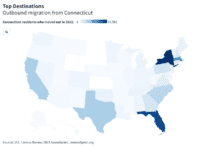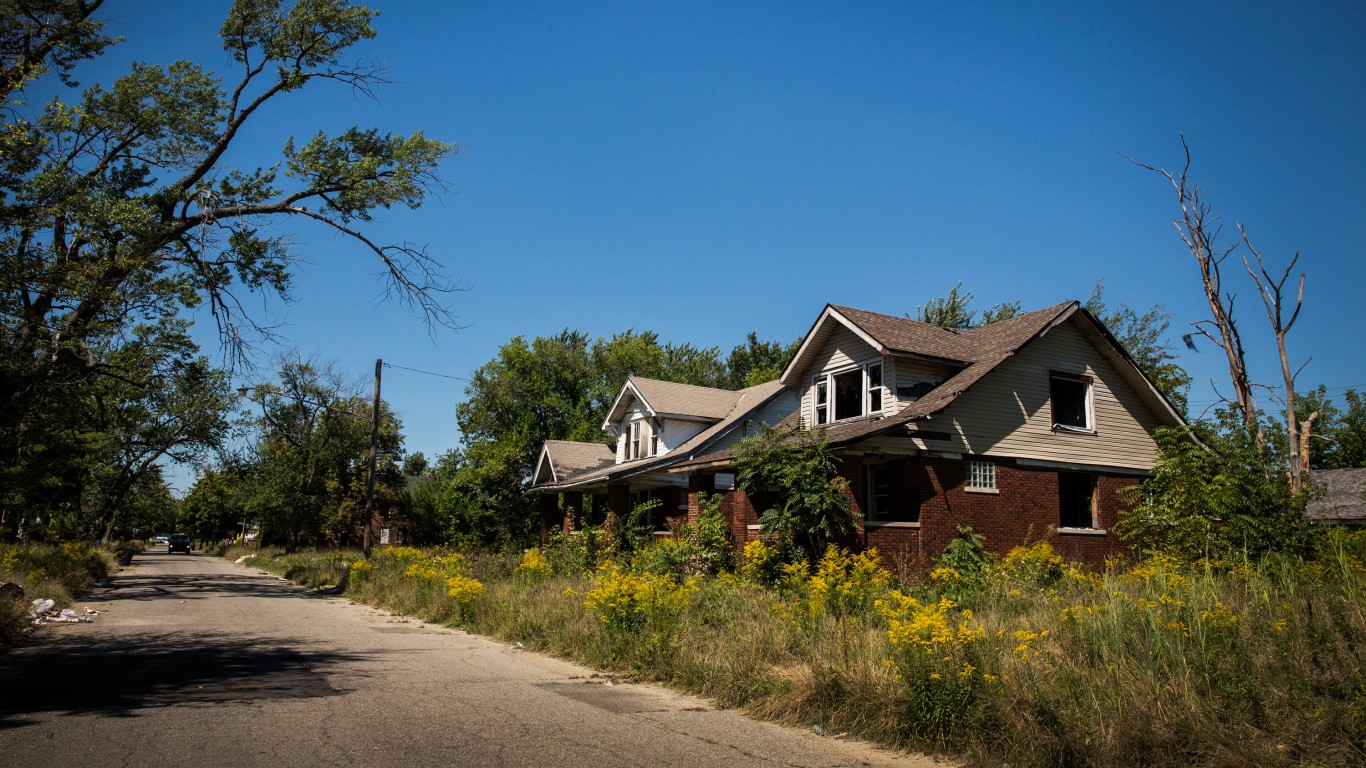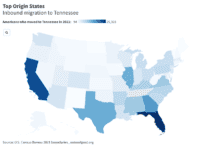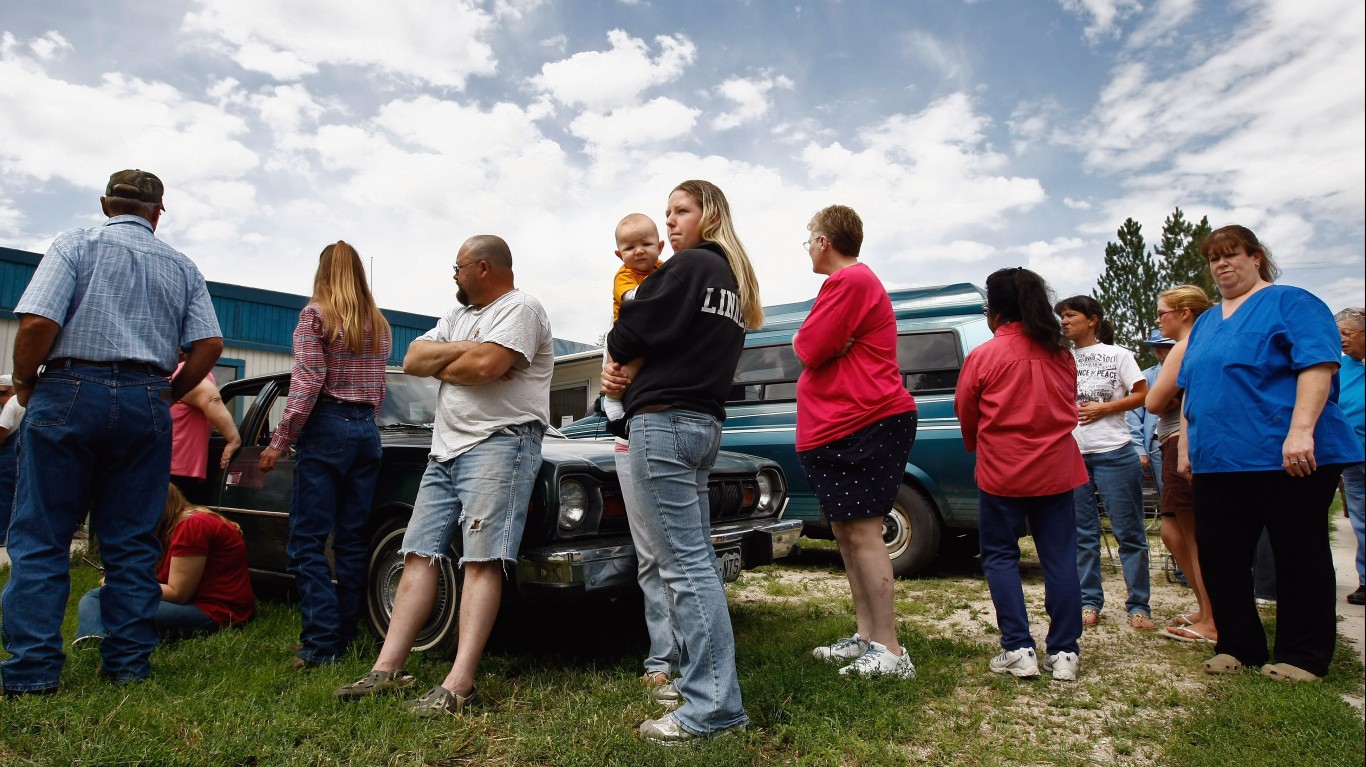
There are an estimated 39.5 million Americans living below the poverty line, which, in the lower 48 states, is an annual income threshold of $12,880 for an individual and $26,500 for a family of four (Alaska and Hawaii have a slightly higher threshold). Living in poverty can have serious consequences and impacts nearly every aspect of life — and those problems can be compounded for those who are facing poverty while also living in very poor neighborhoods.
Residents of poor neighborhoods often struggle with higher crime rates, limited employment opportunities, lower school quality, and worse health outcomes. For those living on poverty level income, each of these factors can reduce the likelihood of upward economic mobility.
Using data from the U.S. Census Bureau, 24/7 Wall St. identified the city in every state hit hardest by extreme poverty. We ranked metro areas in each state by the share of the population living below the poverty line in neighborhoods with poverty rates of 40% or higher.
A lack of economic opportunity in the poorest neighborhoods in cities across the United States makes it more difficult for many residents to pull themselves out of poverty. For example, only about 62% of households in high-poverty neighborhoods have internet access, compared to over 80% of all U.S. households. Additionally, the five-year average unemployment rate in high-poverty neighborhoods in U.S. metro areas is 12.9%, more than double the 5.2% jobless rate in metro area neighborhoods with poverty rates below 40%.
In keeping with the national pattern, in most of the cities hit hardest by extreme poverty in each state, the jobless rate in poor neighborhoods is more than double the rate in the rest of the city. Here is a look at the states where people gave up looking for jobs during the pandemic.
Click here to see the city hit hardest by extreme poverty in every state
To identify the city hit hardest by extreme poverty in every state, 24/7 Wall St. reviewed five-year data on concentrated poverty from the U.S. Census Bureau’s 2019 American Community Survey. Metropolitan areas were ranked based on the share of poor residents who live in extreme poverty neighborhoods — census tracts with a poverty rate of 40% or higher. This measure is called the extreme or concentrated poverty rate, and is calculated by aggregating data from the census tract level to the metropolitan area level.
In our analysis, we only considered census tracts with at least 500 people and college or graduate school enrollment below 50%. Metro areas were also excluded if over 25% of the population in tracts or neighborhoods of concentrated poverty were college or university students. Data was aggregated using boundary definitions for March 2020 from the Census Bureau.
All other data referenced, including educational attainment, homeownership, internet access, SNAP benefit recipiency, average household income, and unemployment are also from the 2019 ACS. Figures were aggregated from the census tract to the metropolitan level.
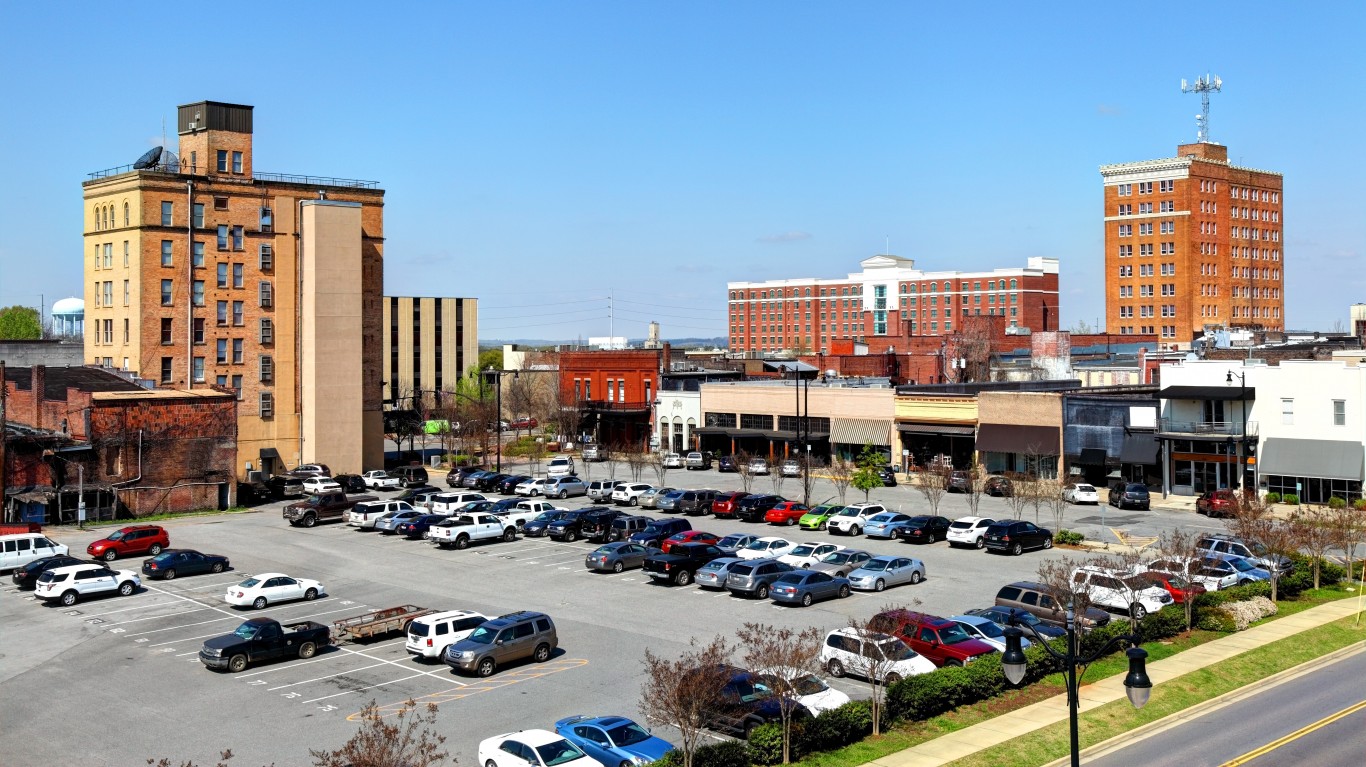
Alabama: Tuscaloosa
> Concentrated poverty rate: 16.7% of poor pop. live in poor neighborhoods
> Overall poverty rate: 18.2% (state: 16.7%)
> Neighborhoods with concentrated poverty: 7 out of 57
> 5-yr. avg. unemployment rate: 9.6% in poor neighborhoods; 5.9% in all other neighborhoods
Tuscaloosa has the worst problem with concentrated poverty of any metro area in Alabama. An estimated 42,200 Tuscaloosa residents live below the poverty line, and 16.7% of them live in neighborhoods of concentrated poverty — meaning at least 40% of residents live on poverty level income.
Areas of such concentrated poverty typically have limited economic opportunities. In the seven Tuscaloosa neighborhoods where at least 40% of residents live in poverty, the average unemployment rate stands at 9.6%, compared to the average jobless rate of 5.9% in the rest of the metro area.
[in-text-ad]
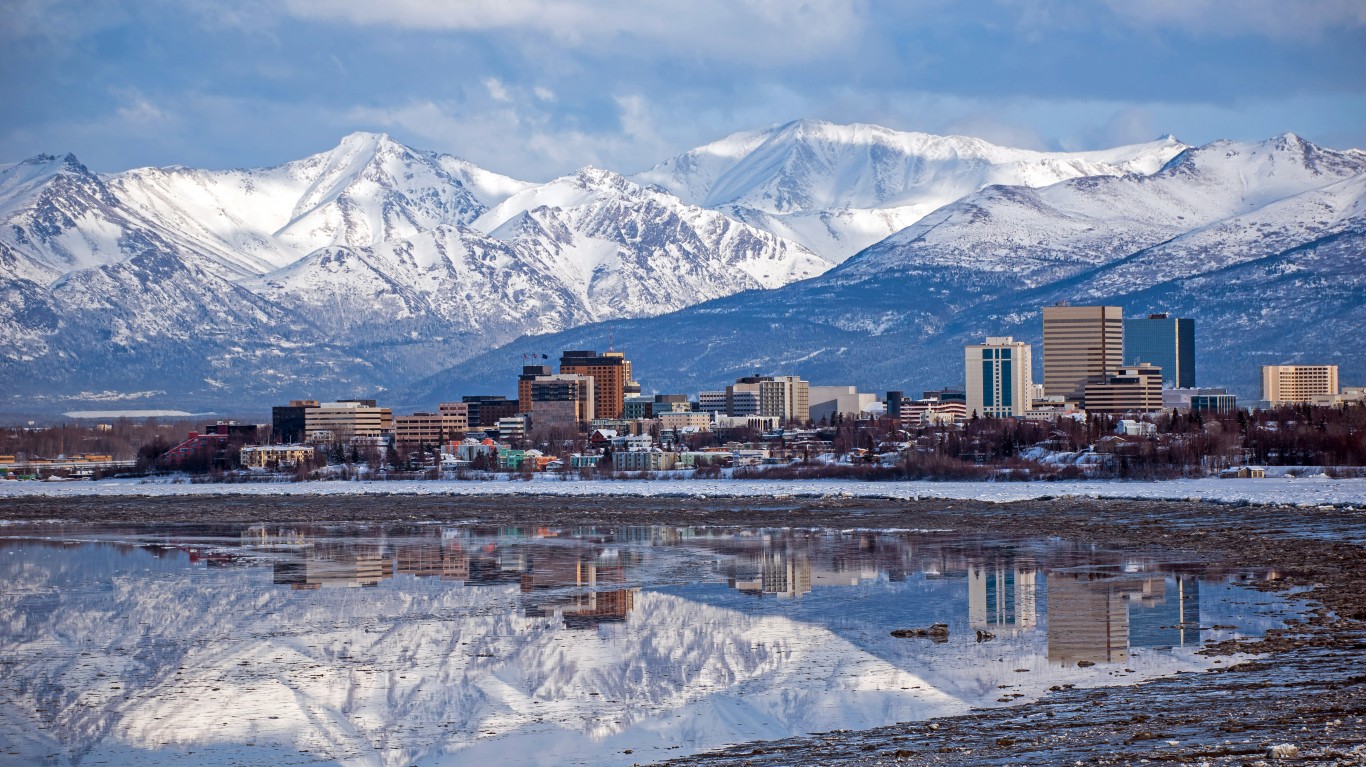
Alaska: No metro area with concentrated poverty
> State poverty rate: 10.7%
There are no neighborhoods in either of Alaska’s two metro areas — Anchorage and Fairbanks — in which 40% or more of the population live below the poverty line. In fact, poverty in general is less common in Alaska’s metropolitan areas than it is across the state as a whole. In Anchorage, 9.4% of residents live below the poverty line, and the poverty rate in Fairbanks is even lower, at 8.0%. Meanwhile, 10.7% of all Alaskans live below the poverty line.
Neighborhoods with concentrated poverty often have relatively limited employment opportunities, and both Anchorage and Fairbanks have stronger job markets than Alaska as a whole. Over the last five years, an average of 6.8% of labor force participants in Alaska were unemployed — a larger share than the 6.2% and 5.8% jobless rates in Anchorage and Fairbanks, respectively.
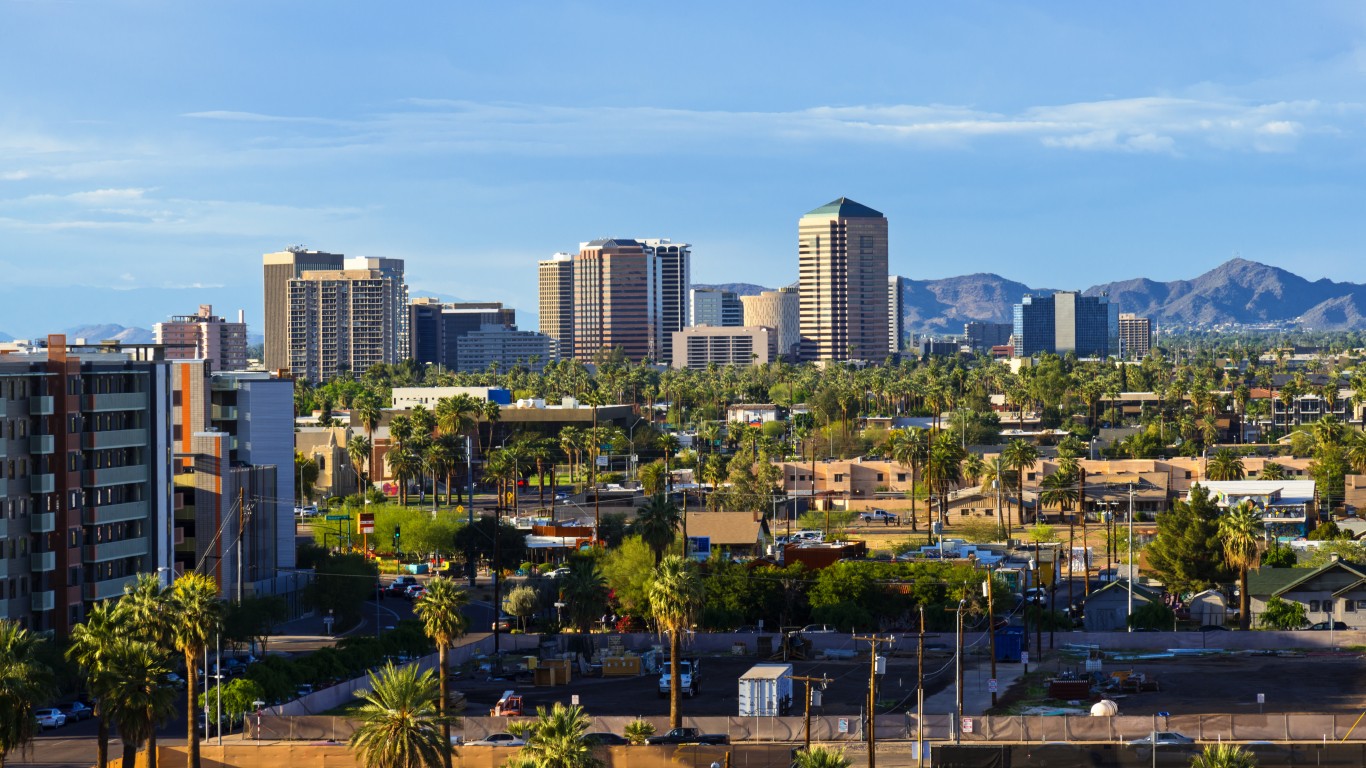
Arizona: Phoenix-Mesa-Chandler
> Concentrated poverty rate: 9.9% of poor pop. live in poor neighborhoods
> Overall poverty rate: 13.6% (state: 15.1%)
> Neighborhoods with concentrated poverty: 34 out of 975
> 5-yr. avg. unemployment rate: 8.6% in poor neighborhoods; 5.1% in all other neighborhoods
Poverty level-income residents in the Phoenix metro area are more likely to be isolated in high-poverty neighborhoods than those in any other city in Arizona. Nearly one in every 10 people living below the poverty line in the metro area reside in a neighborhood with a 40% or higher poverty rate. Though Flagstaff has a higher concentrated poverty rate, it is driven up by a large college and university student population, and is therefore not an accurate portrayal of financial hardship.
In the 34 neighborhoods across the Phoenix metro area where at least 40% of the population live in poverty, residents are less likely to own their home, less likely to have internet access, and less likely to be employed than those living in the rest of the city.
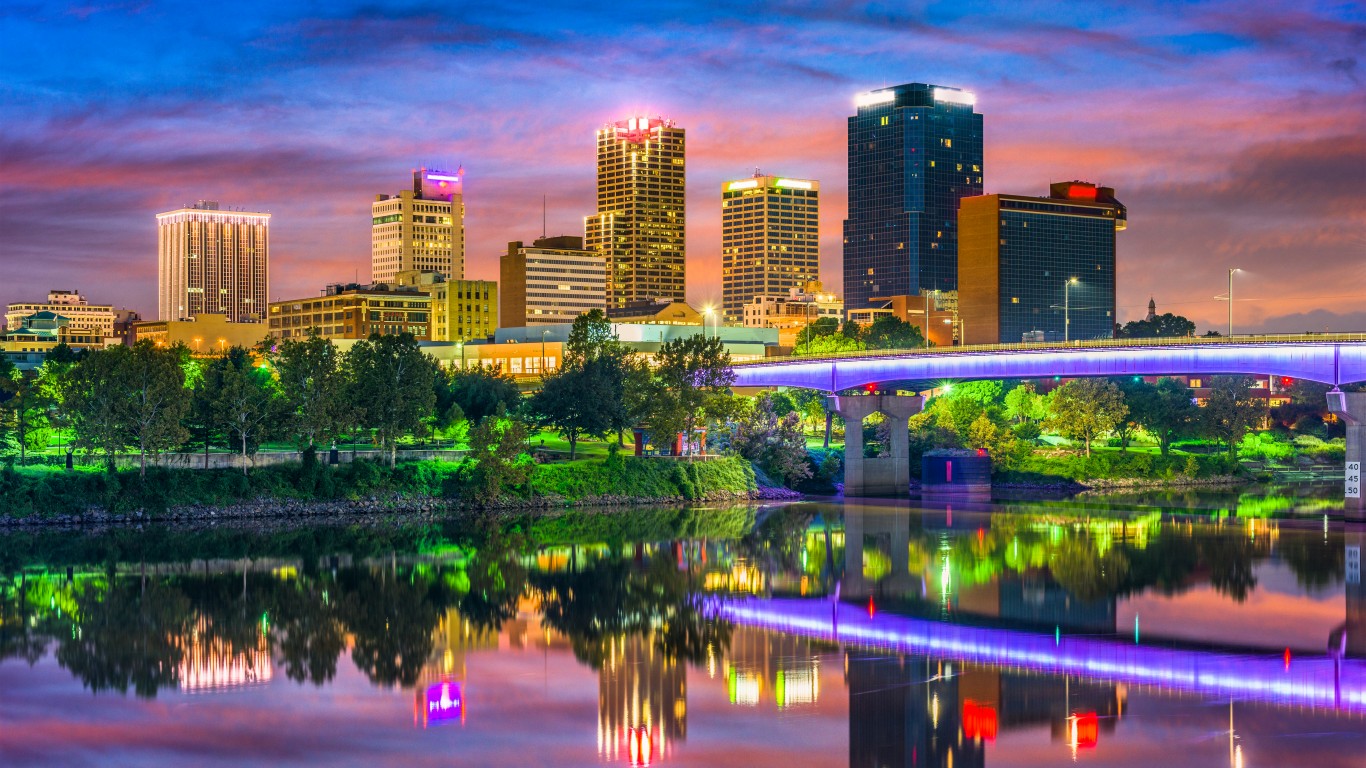
Arkansas: Little Rock-North Little Rock-Conway
> Concentrated poverty rate: 7.8% of poor pop. live in poor neighborhoods
> Overall poverty rate: 15.0% (state: 17.0%)
> Neighborhoods with concentrated poverty: 7 out of 162
> 5-yr. avg. unemployment rate: 11.2% in poor neighborhoods; 4.0% in all other neighborhoods
Poor residents of the Little Rock metropolitan area are more likely to live in concentrated poverty neighborhoods than those of any of the five other Arkansas metro areas. Nearly 8% of the 107,800 Little Rock residents living below the poverty line are in one of the seven area neighborhoods where over 40% of the population live below the poverty line.
For many in these neighborhoods, upward mobility is limited, partially due to reduced access to information and job opportunities. For example, only 54% of households in the metro area’s high-poverty neighborhoods have internet access, compared to 80% of all households across the metro area. Additionally, unemployment in Little Rock’s poorest neighborhoods stands at 11.2% — more than double the 4.0% jobless rate in the rest of the city.
[in-text-ad-2]

California: Fresno
> Concentrated poverty rate: 28.5% of poor pop. live in poor neighborhoods
> Overall poverty rate: 22.5% (state: 13.4%)
> Neighborhoods with concentrated poverty: 32 out of 198
> 5-yr. avg. unemployment rate: 13.9% in poor neighborhoods; 8.0% in all other neighborhoods
Fresno has the highest concentrated poverty rate of any metro area in California and one of the highest of any metro area nationwide. There are 32 neighborhoods in the city with poverty rates of 40% and up — and they are home to nearly 29% of the 217,400 area residents living below the poverty line.
Many living in Fresno’s high-poverty neighborhoods face barriers to economic opportunity due to low educational attainment. For example, only 56.6% of adults in neighborhoods with poverty rates of 40% or higher have a high school diploma and just 6.7% have a four-year college degree. Meanwhile, in the rest of the city, 78.8% of adults completed high school, and 23.4% have a bachelor’s degree.
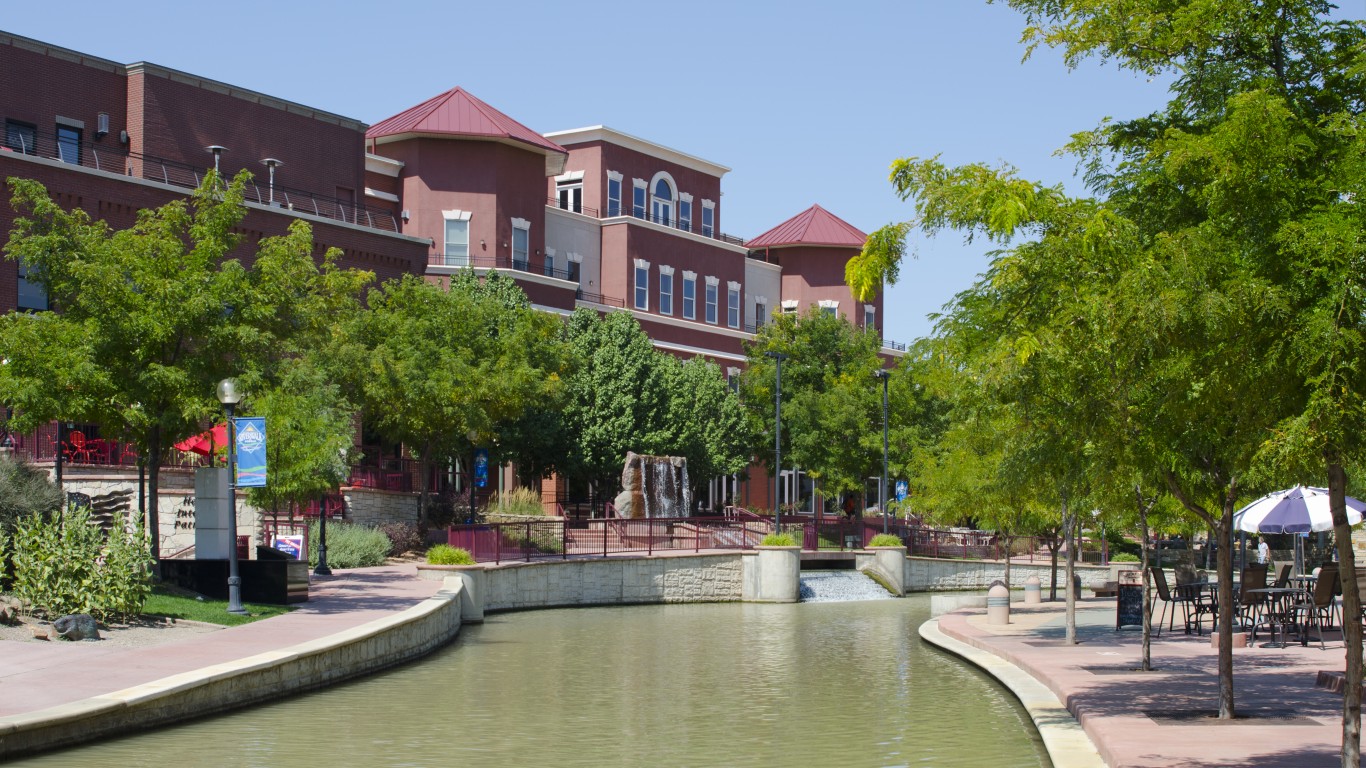
Colorado: Pueblo
> Concentrated poverty rate: 5.9% of poor pop. live in poor neighborhoods
> Overall poverty rate: 18.8% (state: 10.3%)
> Neighborhoods with concentrated poverty: 2 out of 53
> 5-yr. avg. unemployment rate: 10.8% in poor neighborhoods; 7.4% in all other neighborhoods
Of the seven metro areas in Colorado, Pueblo has the highest concentrated poverty rate not distorted by large college and university student populations. An estimated 1,800 people in the metro area — 5.9% of the total impoverished population — live below the poverty line in neighborhoods with poverty rates of 40% or higher.
In the two Pueblo neighborhoods characterized by concentrated poverty, only 53.9% of residents have internet access, compared to more than three-quarters of all metro area residents. Additionally, the average unemployment rate in these areas of 10.8% is well above the 7.4% jobless rate in the rest of the city.
[in-text-ad]

Connecticut: New Haven-Milford
> Concentrated poverty rate: 12.7% of poor pop. live in poor neighborhoods
> Overall poverty rate: 11.7% (state: 9.9%)
> Neighborhoods with concentrated poverty: 8 out of 186
> 5-yr. avg. unemployment rate: 17.4% in poor neighborhoods; 6.2% in all other neighborhoods
Across the New Haven metro area, there are eight neighborhoods with poverty rates of at least 40% — and they are home to 12.7% of the city’s poor population, the largest such share of Connecticut’s four metro areas.
Homeownership is one of the most practical ways to build wealth in the United States, but in New Haven’s poorest neighborhoods, few residents own their home. The average homeownership rate across concentrated poverty neighborhoods in the city is just 17.1%, compared to the 61.9% homeownership rate across the entire metro area.
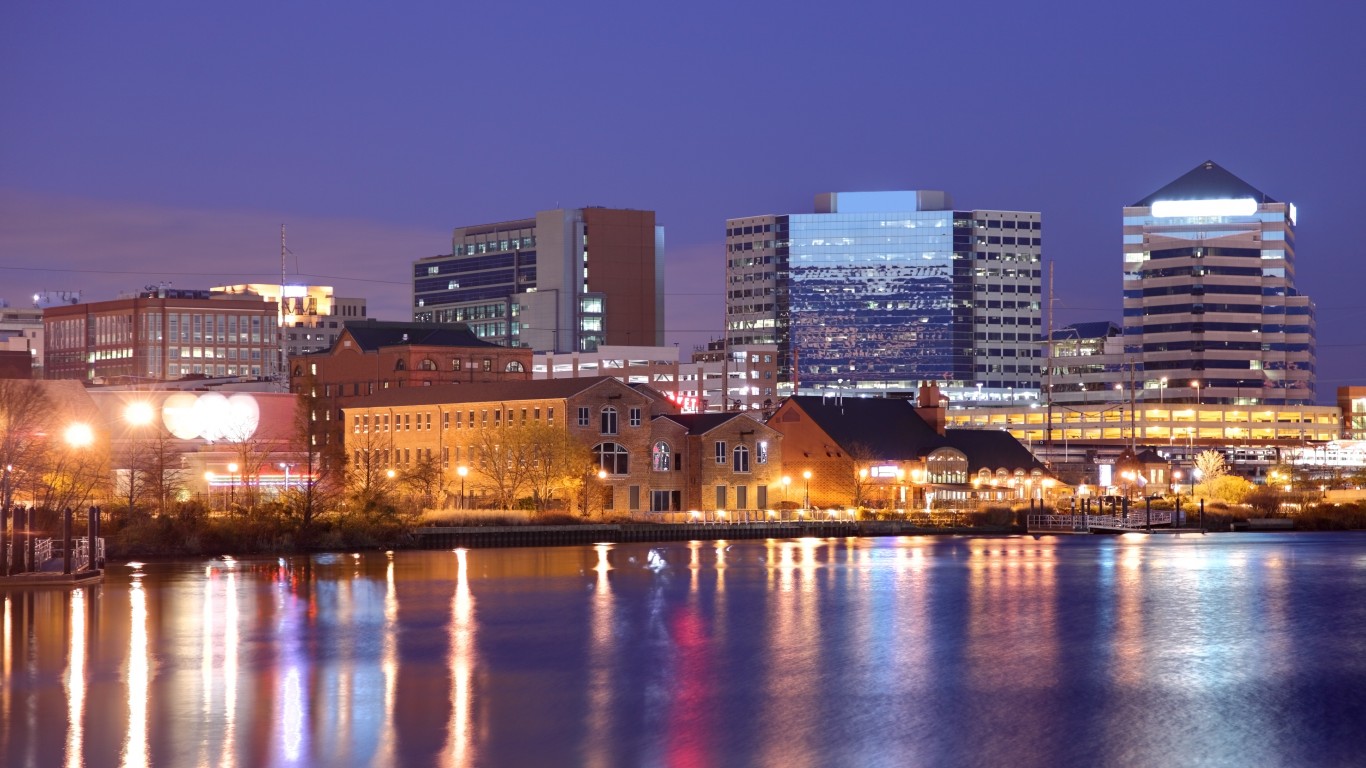
Delaware: No metro area with concentrated poverty
> State poverty rate: 11.8%
Dover is the only metro area in Delaware — and none of the city’s 32 neighborhoods have a poverty rate of 40% or higher. Still, Dover residents are more likely to live on poverty level income than the typical Delaware resident. An estimated 13.5% of people in Dover live below the poverty line compared to 11.8% of Delaware residents.
Adults with a college degree are far less likely to face serious financial hardship than those with lower educational attainment, and across Delaware, 32.0% of adults have a bachelor’s degree, compared to 23.7% of adults in Dover.
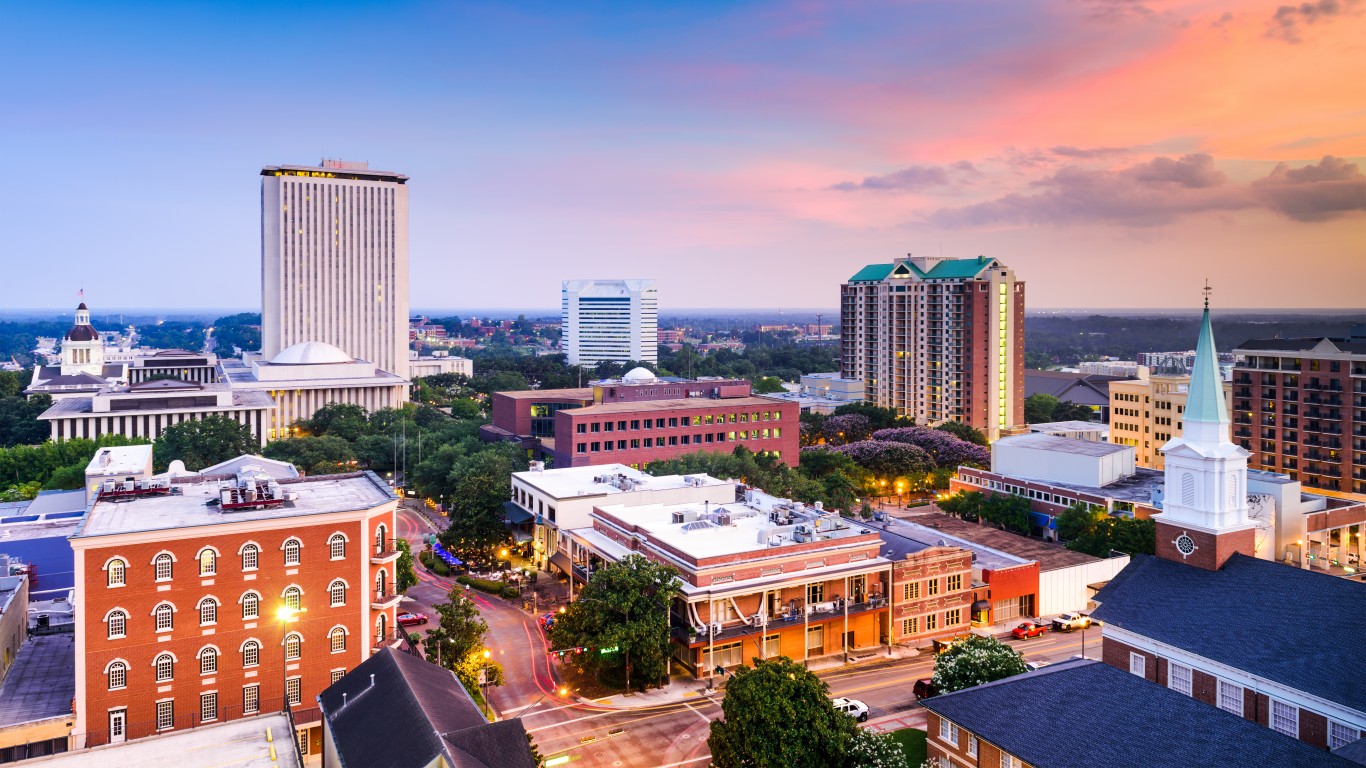
Florida: Tallahassee
> Concentrated poverty rate: 21.5% of poor pop. live in poor neighborhoods
> Overall poverty rate: 15.8% (state: 14.0%)
> Neighborhoods with concentrated poverty: 8 out of 75
> 5-yr. avg. unemployment rate: 14.8% in poor neighborhoods; 5.4% in all other neighborhoods
More than one in every five Tallahassee residents living below the poverty line reside in neighborhoods with 40% poverty rates or higher. The eight neighborhoods characterized by concentrated poverty in the metro area have a five-year average unemployment rate of 14.8% — nearly three times higher than the 5.4% jobless rate in the rest of the city.
With limited employment opportunities, residents of Tallahassee’s concentrated poverty neighborhoods are more likely to rely on government assistance to afford basic necessities. An estimated 34.2% of households in the city’s poorest neighborhoods receive SNAP benefits, well more than double the 12.2% SNAP recipiency rate in the rest of the metro area.
[in-text-ad-2]
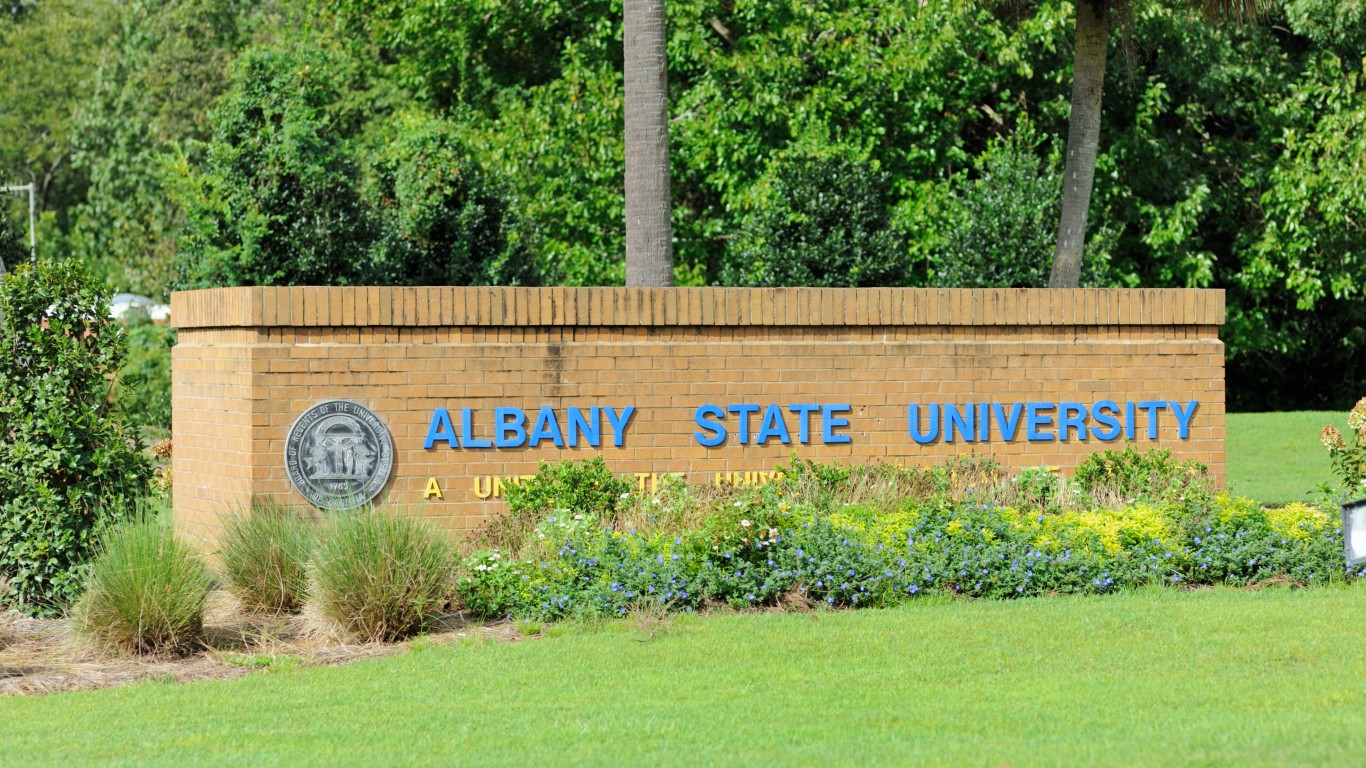
Georgia: Albany
> Concentrated poverty rate: 35.3% of poor pop. live in poor neighborhoods
> Overall poverty rate: 24.2% (state: 15.1%)
> Neighborhoods with concentrated poverty: 9 out of 41
> 5-yr. avg. unemployment rate: 20.3% in poor neighborhoods; 8.8% in all other neighborhoods
Albany has the highest concentrated poverty rate of any metro area in Georgia and one of the highest of any metro area nationwide. There are nine neighborhoods in the city with poverty rates of 40% and up — and they are home to over one-third of the 34,600 people in the metro area living below the poverty line.
Many living in Albany’s high-poverty neighborhoods face barriers to economic opportunity due to low educational attainment. For example, less than three-quarters of adults in neighborhoods with poverty rates of 40% or higher have a high school diploma compared to about 87% of adults in the rest of the city. Additionally, the share of adults with a four-year college education in Albany is more than double the share of adults with such a degree living in the city’s concentrated poverty neighborhoods.

Hawaii: No metro area with concentrated poverty
> State poverty rate: 9.4%
Neither Honolulu nor Kahului-Wailuku-Lahaina, the two metropolitan areas in Hawaii, have any neighborhoods where 40% or more of the population live below the poverty line. In fact, the overall poverty rate in each Hawaiian metro area is lower than it is across the state as a whole. An estimated 9.4% of Hawaiians live below the poverty line, compared to 9.3% of Kahului-Wailuku-Lahaina residents and 8.3% of the population in Honolulu.
In Honolulu, where the poverty rate is considerably lower than it is across the state, an average of only 3.6% of the labor force have been unemployed in the last five years, compared to the 4.0% jobless rate across Hawaii. Unemployment in Kahului-Wailuku-Lahaina is about as common as it is statewide.
[in-text-ad]
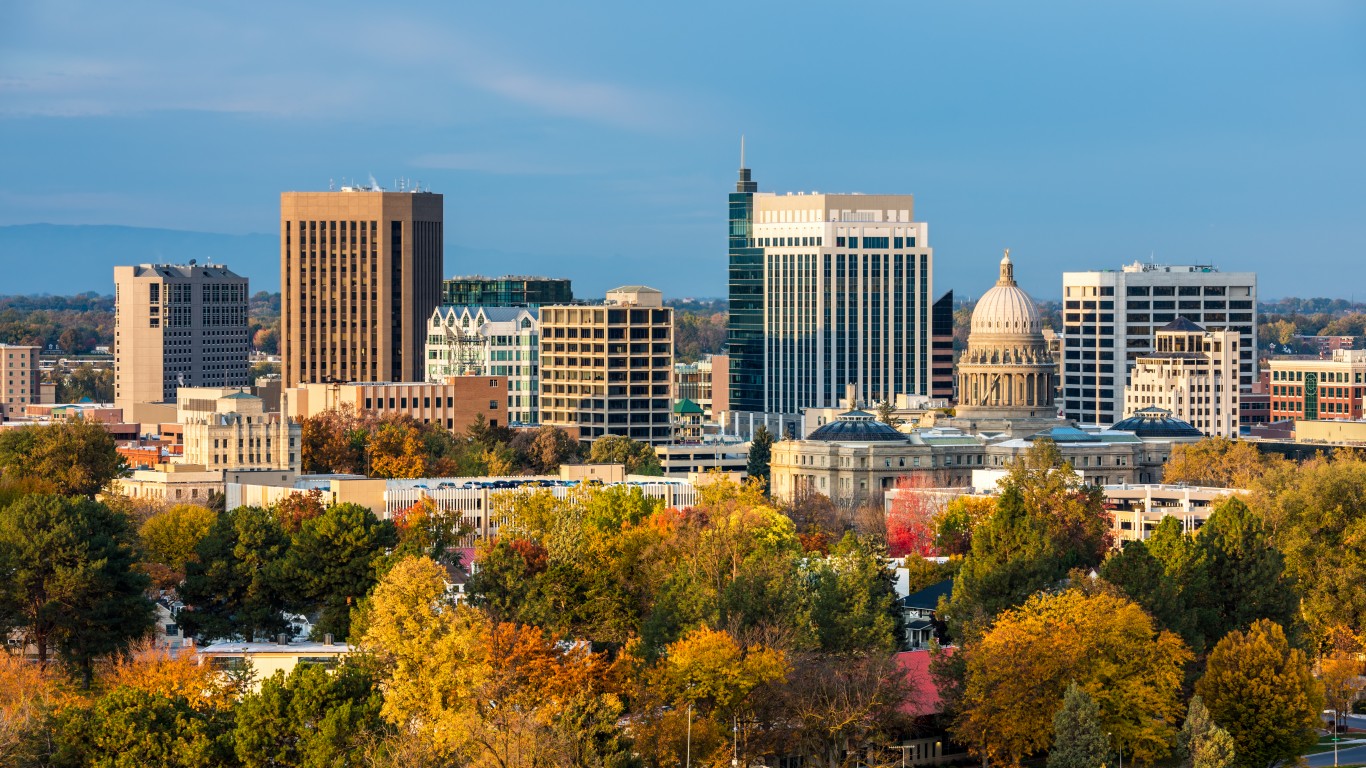
Idaho: No metro area with concentrated poverty
> State poverty rate: 13.1%
There are six metropolitan areas in Idaho, and of them, Pocatello is the only one with neighborhoods where 40% or more of the population live in poverty. However, the presence of colleges can distort poverty rates at a local level, and Pocatello is home to Idaho State University — and over a third of residents in the metro area’s high-poverty neighborhoods are students. As a result, the metro area does not qualify as having concentrated poverty.
Only two metro areas in Idaho — Pocatello and Twin Falls — have a higher overall poverty rate than the 13.1% state average, at 16.0% and 15.3%, respectively.
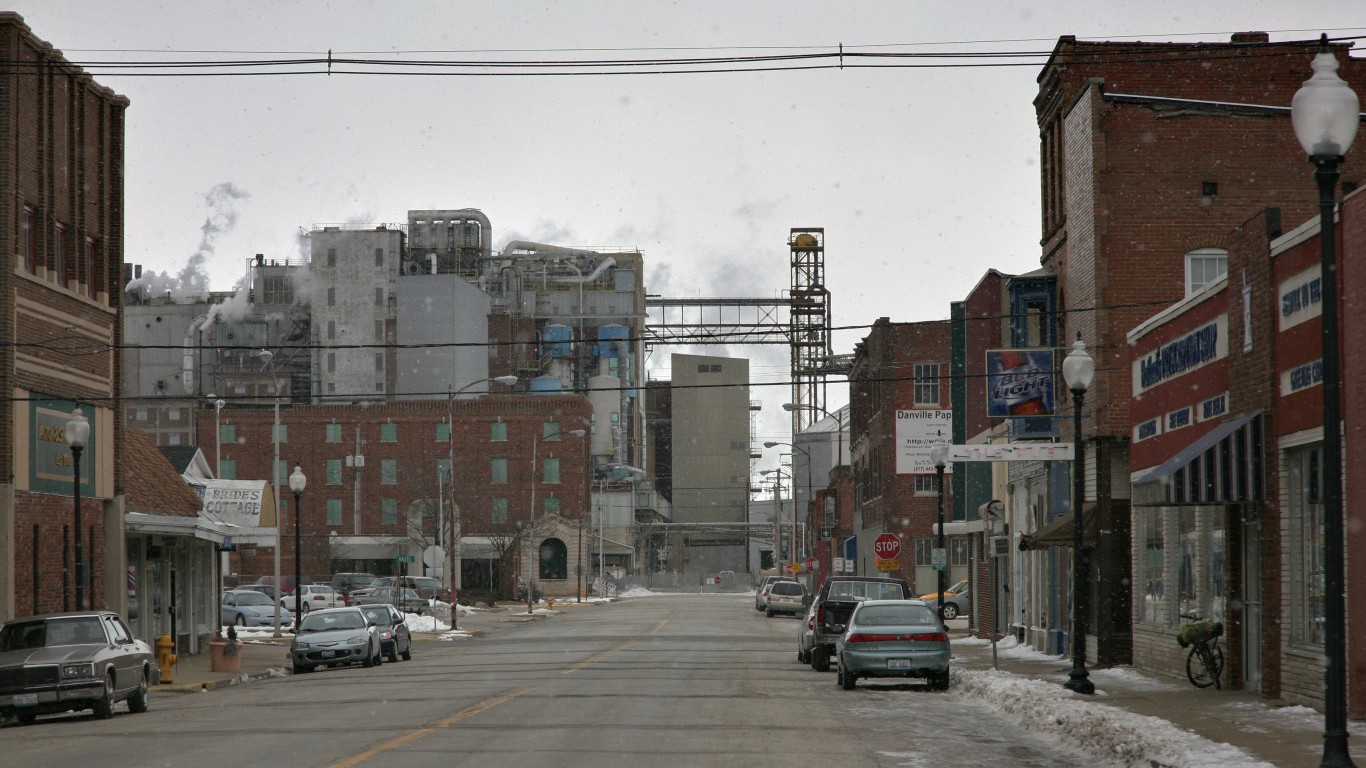
Illinois: Danville
> Concentrated poverty rate: 20.6% of poor pop. live in poor neighborhoods
> Overall poverty rate: 18.9% (state: 12.5%)
> Neighborhoods with concentrated poverty: 2 out of 24
> 5-yr. avg. unemployment rate: 9.2% in poor neighborhoods; 6.4% in all other neighborhoods
There are 10 metropolitan areas in Illinois, and of them, Danville has the highest concentrated poverty rate not distorted by a large college and university student population. More than one in every five Danville residents living below the poverty line are living in neighborhoods where at least 40% of the population also lives in poverty.
Economic opportunity is typically scarce in areas with concentrated poverty. Across Danville’s poorest neighborhoods, an average of 9.2% of the labor force have been unemployed over the last five years, compared to the 6.4% jobless rate in the rest of the metro area.

Indiana: Muncie
> Concentrated poverty rate: 18.7% of poor pop. live in poor neighborhoods
> Overall poverty rate: 17.2% (state: 13.4%)
> Neighborhoods with concentrated poverty: 4 out of 26
> 5-yr. avg. unemployment rate: 9.0% in poor neighborhoods; 5.4% in all other neighborhoods
In Muncie, Indiana, 18.7% of those living below the poverty line reside in a neighborhood with a poverty rate of 40% or higher — the highest concentrated poverty rate of any metro area in the state where concentrated poverty is not distorted by a large college and university student population.
Homeownership is one of the most practical ways to build wealth in the United States. In Muncie’s poorest neighborhoods, the homeownership rate is only 38.3%. Meanwhile, across the rest of the city, the homeownership rate stands at 71.9%.
[in-text-ad-2]
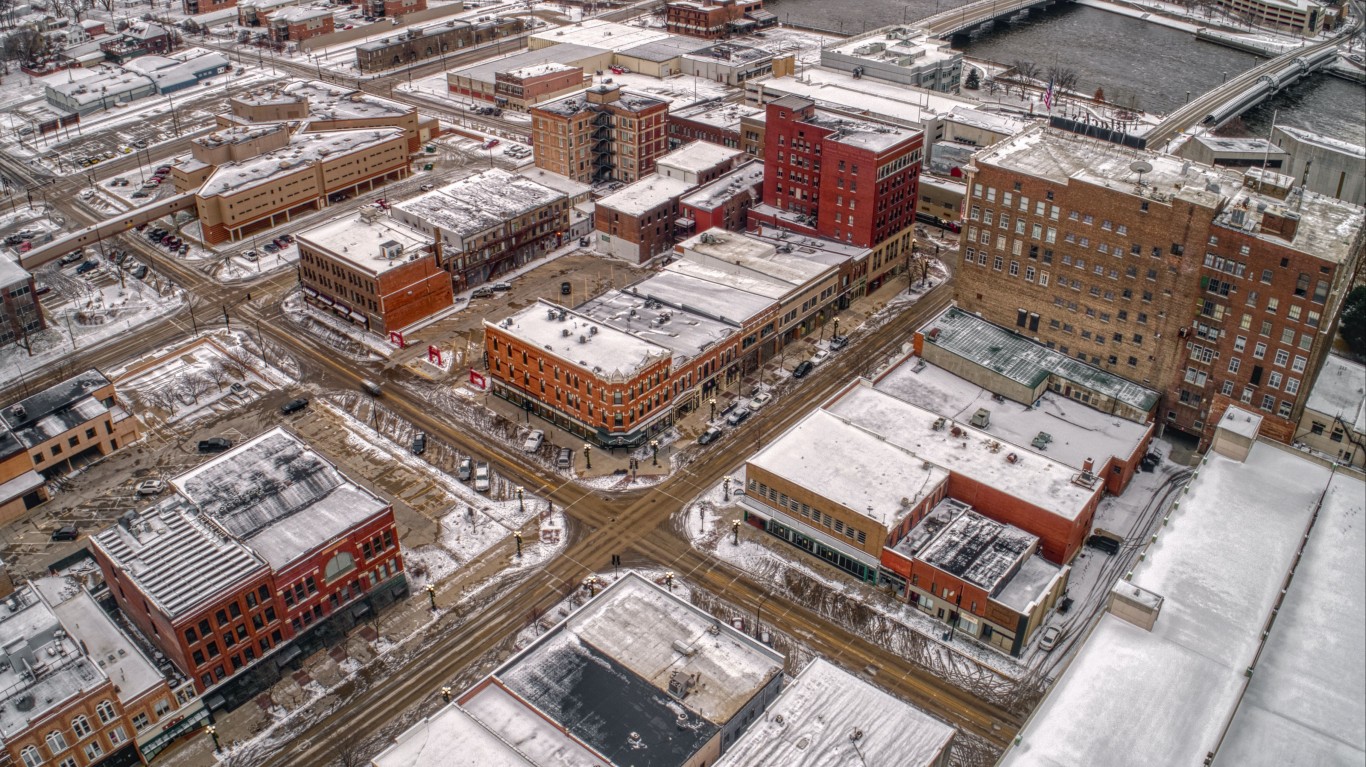
Iowa: Waterloo-Cedar Falls
> Concentrated poverty rate: 9.6% of poor pop. live in poor neighborhoods
> Overall poverty rate: 13.4% (state: 11.5%)
> Neighborhoods with concentrated poverty: 3 out of 48
> 5-yr. avg. unemployment rate: 19.2% in poor neighborhoods; 3.4% in all other neighborhoods
There are eight metro areas across Iowa, and of them, Waterloo-Cedar Falls has the highest concentrated poverty rate. About one in every 10 of the 21,500 people in the metro area living below the poverty line reside in neighborhoods with poverty rates of 40% or higher.
Disparities in economic opportunity between the metro area’s poorest neighborhoods and the rest of the city are staggering. In the parts of Waterloo-Cedar Falls with 40% and higher poverty rates, an average of 19.2% of the labor force have been unemployed over the last five years — more than five times the 3.4% jobless rate in the rest of the metro area.
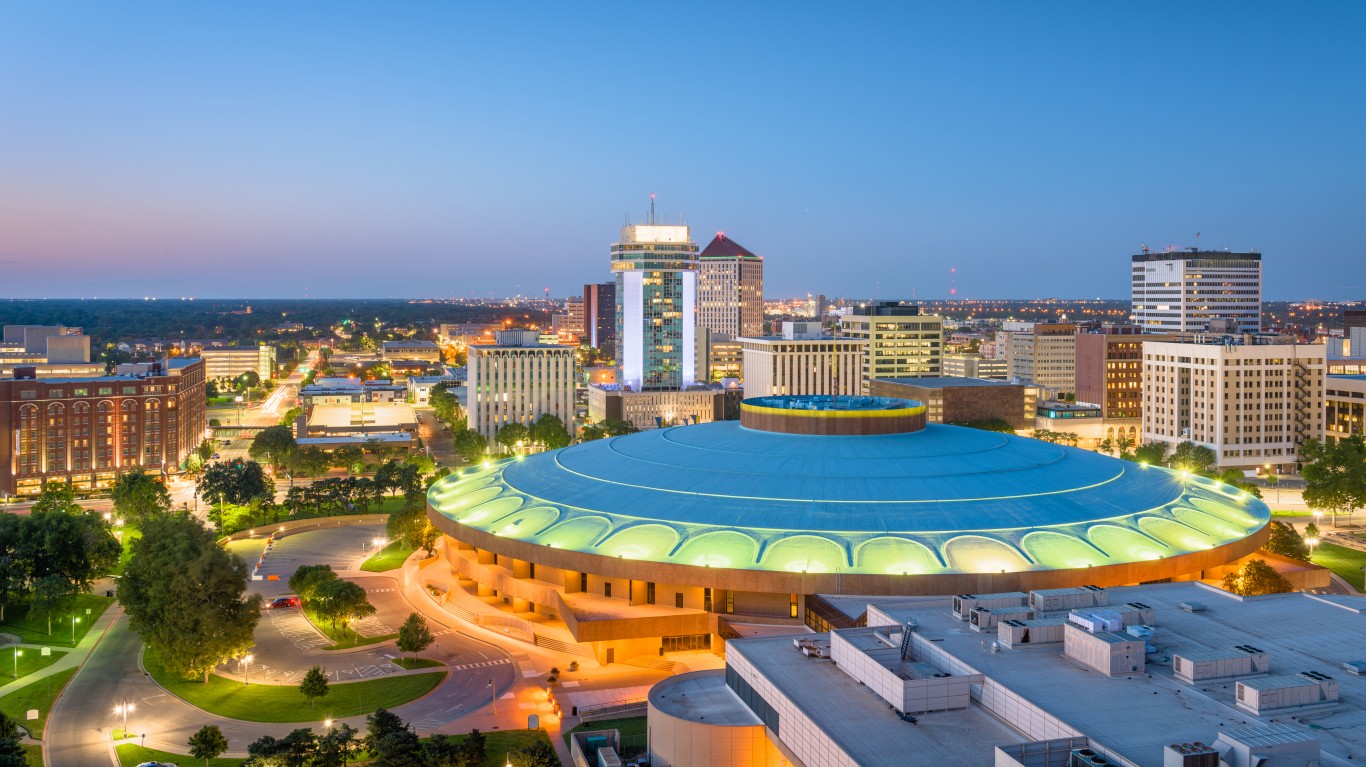
Kansas: Wichita
> Concentrated poverty rate: 5.7% of poor pop. live in poor neighborhoods
> Overall poverty rate: 13.0% (state: 12.0%)
> Neighborhoods with concentrated poverty: 4 out of 149
> 5-yr. avg. unemployment rate: 19.9% in poor neighborhoods; 4.6% in all other neighborhoods
Of the four metro areas in Kansas, Wichita is the only one with concentrated poverty not distorted by a high concentration of college and university students. There are 149 neighborhoods in the city, and four of them have poverty rates of at least 40%. These high-poverty neighborhoods are home to 5.7% of the metro area population who live below the poverty line.
Across the metro area’s poorest neighborhoods, an estimated 19.9% of the labor force are unemployed. Due in part to the lack of opportunity in these areas, the overall jobless rate in Wichita of 4.8% is the highest of any metro area in the state and well above the 4.0% jobless rate across all of Kansas.
[in-text-ad]
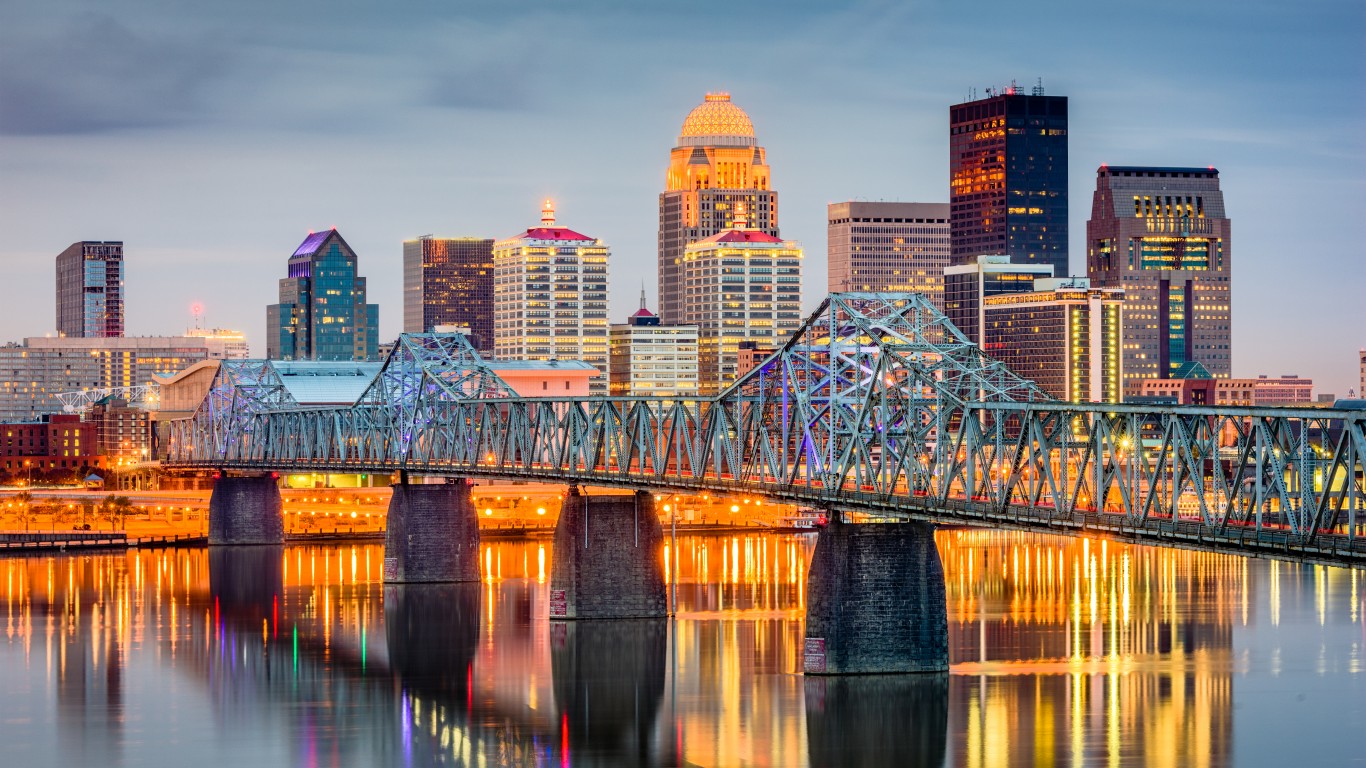
Kentucky: Louisville/Jefferson County
> Concentrated poverty rate: 11.2% of poor pop. live in poor neighborhoods
> Overall poverty rate: 12.3% (state: 17.3%)
> Neighborhoods with concentrated poverty: 12 out of 295
> 5-yr. avg. unemployment rate: 17.7% in poor neighborhoods; 4.7% in all other neighborhoods
The Louisville/Jefferson County metro area has the highest concentrated poverty of the five metro areas in Kentucky. Of the 151,000 people in Louisville living below the poverty line, 11.2% reside in neighborhoods with poverty rates of 40% or higher.
Financial hardship in these areas is further highlighted by income disparities. The average household in the 12 high-poverty neighborhoods in Louisville earns just $31,240 a year — compared to $82,458 in the rest of the metro area.
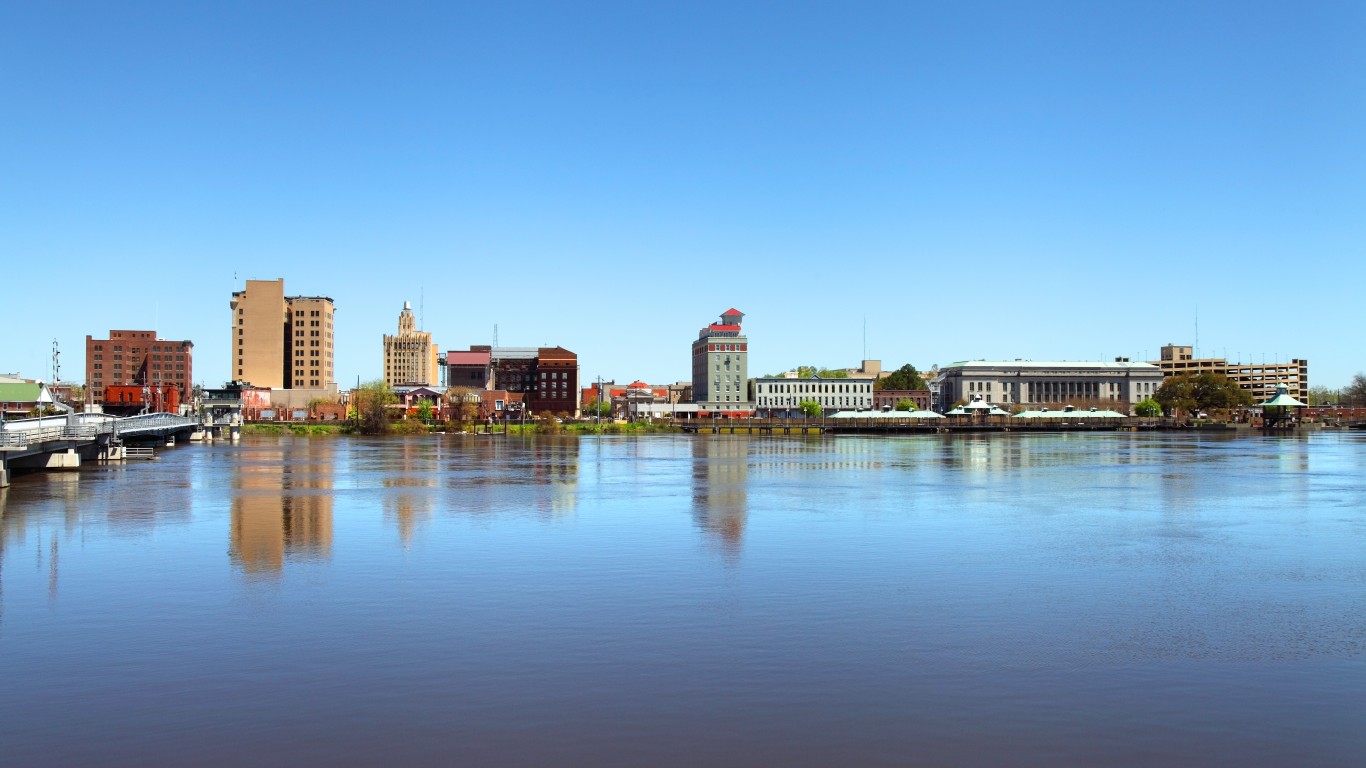
Louisiana: Monroe
> Concentrated poverty rate: 49.5% of poor pop. live in poor neighborhoods
> Overall poverty rate: 24.2% (state: 19.2%)
> Neighborhoods with concentrated poverty: 15 out of 52
> 5-yr. avg. unemployment rate: 10.6% in poor neighborhoods; 4.7% in all other neighborhoods
Monroe, Louisiana, has the highest concentrated poverty rate in the state and the country. About half of the metro area’s population living in poverty reside in neighborhoods with poverty rates of at least 40%.
Not only is poverty more concentrated in Monroe than in other Louisiana metro areas, but it is also more common. The overall poverty rate in Monroe of 24.2% is higher than in any of the eight other metro areas in the state and well above the 19.2% poverty rate in Louisiana, which itself is the second highest poverty rate among states, trailing only Mississippi.
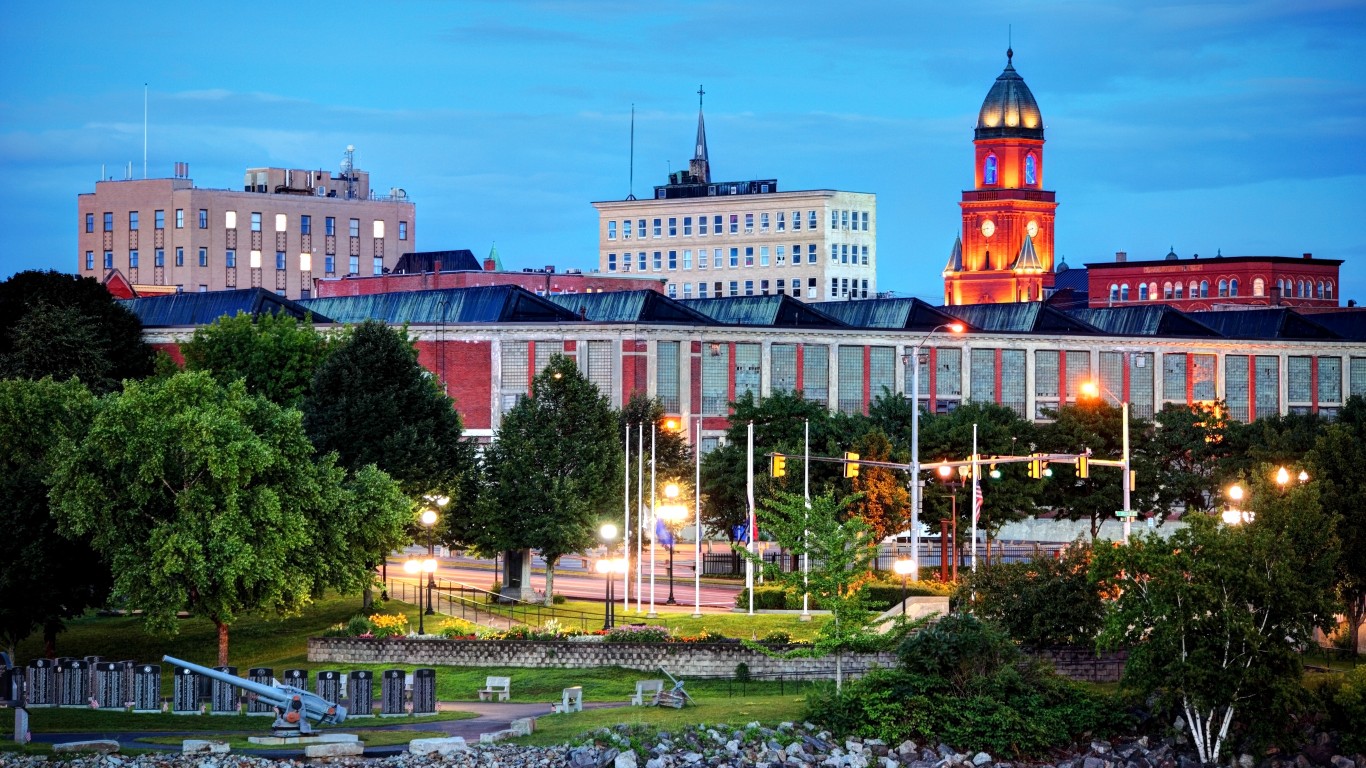
Maine: Lewiston-Auburn
> Concentrated poverty rate: 13.5% of poor pop. live in poor neighborhoods
> Overall poverty rate: 11.8% (state: 11.8%)
> Neighborhoods with concentrated poverty: 2 out of 28
> 5-yr. avg. unemployment rate: 12.4% in poor neighborhoods; 3.7% in all other neighborhoods
Of the three metropolitan areas in Maine, Lewiston-Auburn is the only one with concentrated poverty. Two of the 28 neighborhoods in the metro area have poverty rates of 40% or more — and 13.5% of the 12,300 people living in poverty in the city live in those areas.
Residents of the poorest neighborhoods of Lewiston-Auburn are far more likely to depend on government assistance to afford basic necessities. In the metro area’s high-poverty areas, 55.7% of households receive SNAP benefits, compared to 15.2% of households in the rest of the metro area.
[in-text-ad-2]
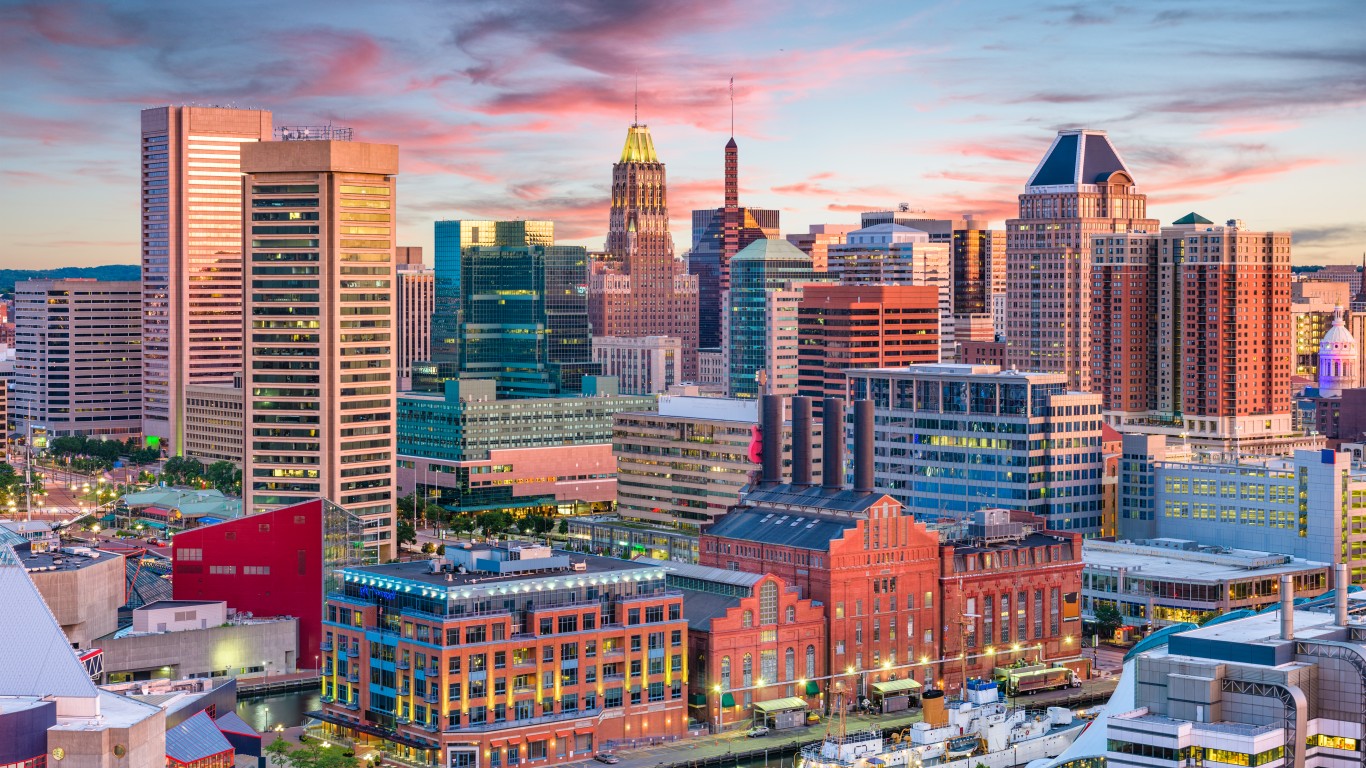
Maryland: Baltimore-Columbia-Towson
> Concentrated poverty rate: 9.3% of poor pop. live in poor neighborhoods
> Overall poverty rate: 10.0% (state: 9.2%)
> Neighborhoods with concentrated poverty: 23 out of 668
> 5-yr. avg. unemployment rate: 17.5% in poor neighborhoods; 4.9% in all other neighborhoods
There are five metro areas in Maryland, and of them, Baltimore is the only one with neighborhoods of concentrated poverty. Of the 668 census tracts that comprise the Baltimore area, 23 have poverty rates of 40% or more — and these areas are home to 9.3% of the city’s 273,400 residents living below the poverty line.
Incomes tend to rise with educational attainment, and though Baltimore is the best educated metro area in Maryland, with a 40.3% bachelor’s degree attainment rate, the poor areas of the city are home to far fewer college-educated residents. Only 7.8% of adults in Baltimore’s high-poverty neighborhoods have a bachelor’s degree.
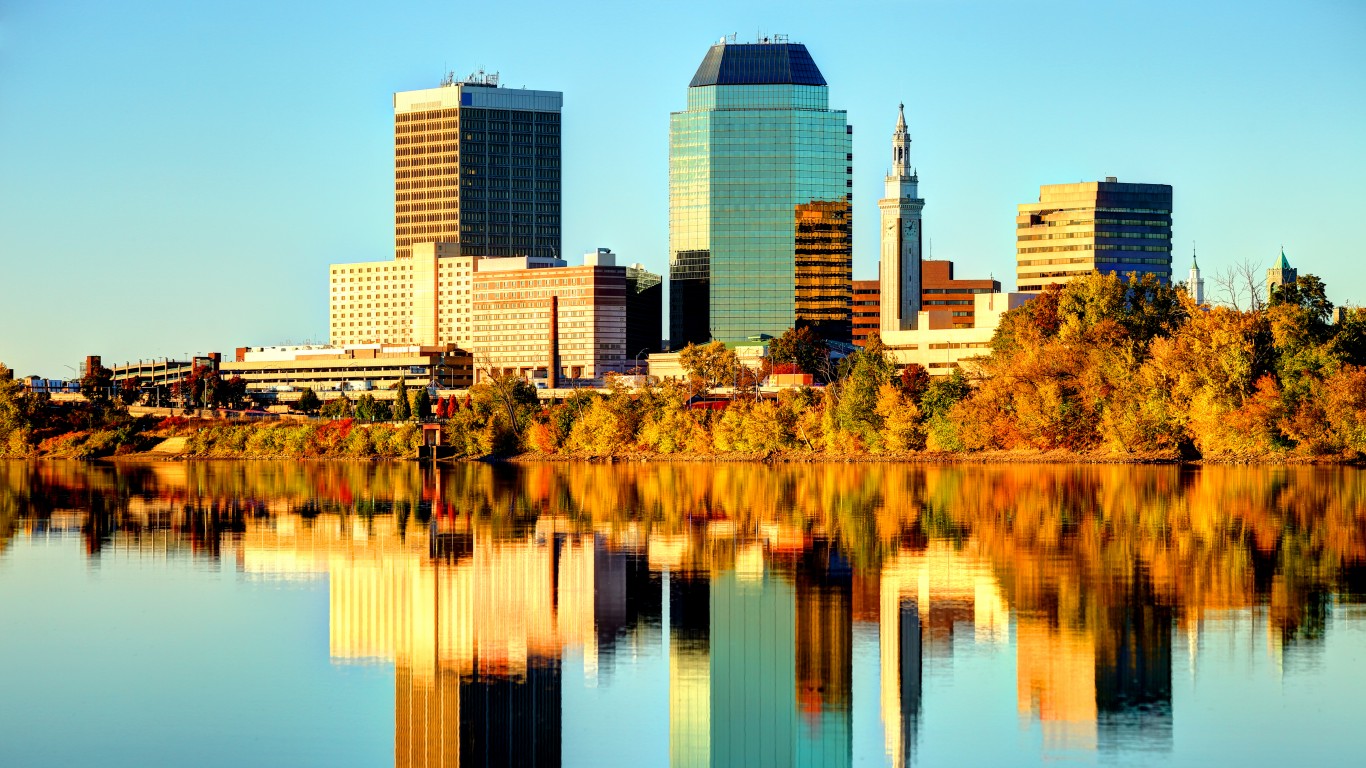
Massachusetts: Springfield
> Concentrated poverty rate: 23.4% of poor pop. live in poor neighborhoods
> Overall poverty rate: 14.8% (state: 10.3%)
> Neighborhoods with concentrated poverty: 15 out of 151
> 5-yr. avg. unemployment rate: 13.7% in poor neighborhoods; 5.0% in all other neighborhoods
Nearly one in every four of the 97,700 residents of Springfield, Massachusetts, who live below the poverty line are in high-poverty neighborhoods — where at least 40% of the population live in poverty. Pittsfield is the metro area with the second highest concentrated poverty rate in Massachusetts, and fewer than one in every 10 people living below the poverty line there reside in high-poverty neighborhoods.
Educational attainment rates in Springfield’s poorest neighborhoods are low. Only 62.7% of adults in the city’s 15 high-poverty neighborhoods have a high school diploma and 9.3% have a college degree — compared to 90.0% and 34.1%, respectively, in the rest of the city.
[in-text-ad]
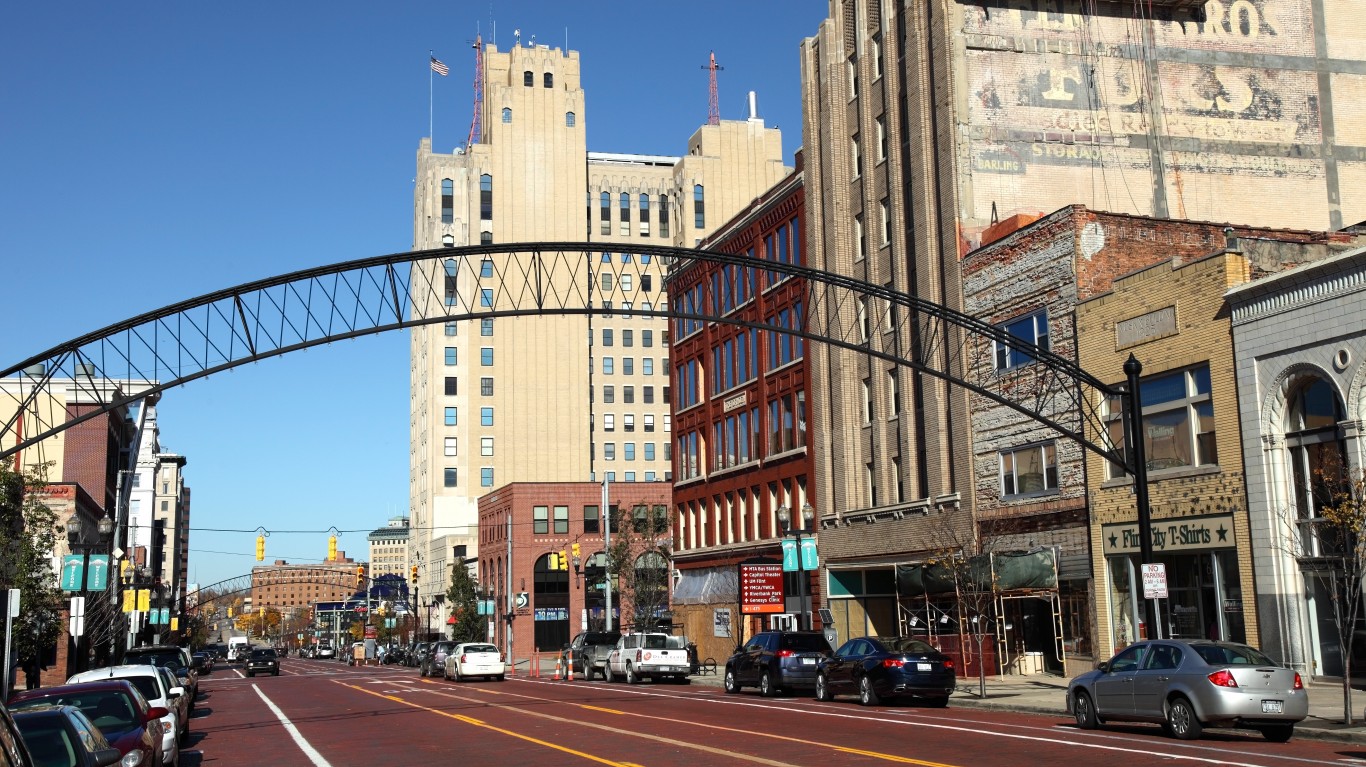
Michigan: Flint
> Concentrated poverty rate: 32.4% of poor pop. live in poor neighborhoods
> Overall poverty rate: 18.9% (state: 14.4%)
> Neighborhoods with concentrated poverty: 20 out of 129
> 5-yr. avg. unemployment rate: 23.8% in poor neighborhoods; 7.5% in all other neighborhoods
An estimated 32.4% of the population of Flint, Michigan, living below the poverty line reside in high-poverty neighborhoods — by far the highest concentrated poverty rate of the 14 metro areas in the state. The next highest concentrated poverty rate in the state is in Niles, where 26.2% of the poor population are concentrated in high-poverty neighborhoods.
Across the metro area’s poorest neighborhoods, an estimated 23.8% of the labor force are unemployed. Due in part to the lack of opportunity in these areas, the overall jobless rate in Flint of 9.3% is the highest of any metro area in the state and well above the 5.9% jobless rate across all of Michigan.

Minnesota: Duluth
> Concentrated poverty rate: 7.9% of poor pop. live in poor neighborhoods
> Overall poverty rate: 13.0% (state: 9.7%)
> Neighborhoods with concentrated poverty: 3 out of 87
> 5-yr. avg. unemployment rate: 9.6% in poor neighborhoods; 3.9% in all other neighborhoods
The Duluth metro area has the worst extreme poverty in Minnesota, with 7.9% of residents living below the poverty line concentrated in high-poverty neighborhoods. Though the Mankato and St. Cloud metro areas have higher concentrated poverty, these cities are also home to major universities and large student populations — which can distort poverty measurements.
High-poverty areas typically have limited economic opportunities. In Duluth, labor force participants in the three neighborhoods with poverty rates of 40% or higher are more than twice as likely to be unemployed as those living in the rest of the city.

Mississippi: Jackson
> Concentrated poverty rate: 21.3% of poor pop. live in poor neighborhoods
> Overall poverty rate: 16.9% (state: 20.3%)
> Neighborhoods with concentrated poverty: 17 out of 132
> 5-yr. avg. unemployment rate: 19.0% in poor neighborhoods; 6.5% in all other neighborhoods
The poverty rate in Jackson, Mississippi, of 16.9% is below the poverty rate in both Hattiesburg and Gulfport-Biloxi — the only two other metro areas in the state — and the 20.3% poverty rate across Mississippi as a whole. While it is not the poorest metro area in the state, Jackson still has the highest concentrated poverty rate, with 21.3% of poor residents living in neighborhoods with poverty rates of 40% or higher. No other metro area in the state has a concentrated poverty rate above 19%.
Financial hardship in Jackson’s high-poverty areas is further highlighted by disparities in income. The average household in the 17 high-poverty neighborhoods in the metro area is just $38,064 — compared to $75,178 in the rest of the metro area.
[in-text-ad-2]

Missouri: Cape Girardeau
> Concentrated poverty rate: 27.9% of poor pop. live in poor neighborhoods
> Overall poverty rate: 16.4% (state: 13.7%)
> Neighborhoods with concentrated poverty: 4 out of 22
> 5-yr. avg. unemployment rate: 9.7% in poor neighborhoods; 3.8% in all other neighborhoods
There are eight metro areas in Missouri — and of them, Cape Girardeau, has far and away the highest concentrated poverty rate. An estimated 27.9% of the metro area’s poor population reside in neighborhoods with poverty rates of at least 40%. None of the other metro areas in the state have a concentrated poverty rate above 10%.
Areas of such concentrated poverty typically have limited economic opportunities. In the four Cape Girardeau neighborhoods where at least 40% of residents live in poverty, the average unemployment rate stands at 9.7%, compared to the average jobless rate of 3.8% in the rest of the metro area.

Montana: Great Falls
> Concentrated poverty rate: 19.8% of poor pop. live in poor neighborhoods
> Overall poverty rate: 13.3% (state: 13.1%)
> Neighborhoods with concentrated poverty: 2 out of 22
> 5-yr. avg. unemployment rate: 10.3% in poor neighborhoods; 3.3% in all other neighborhoods
Of the three metro areas in Montana, Great Falls is the only one with neighborhoods where 40% or more of the population live below the poverty line. Nearly 20% of the 10,600 people in Great Falls living below the poverty line are concentrated in just two neighborhoods.
In those two concentrated-poverty areas, the five-year average unemployment rate stands at 10.3%, more than triple the 3.3% jobless rate in the rest of the metro area.
[in-text-ad]
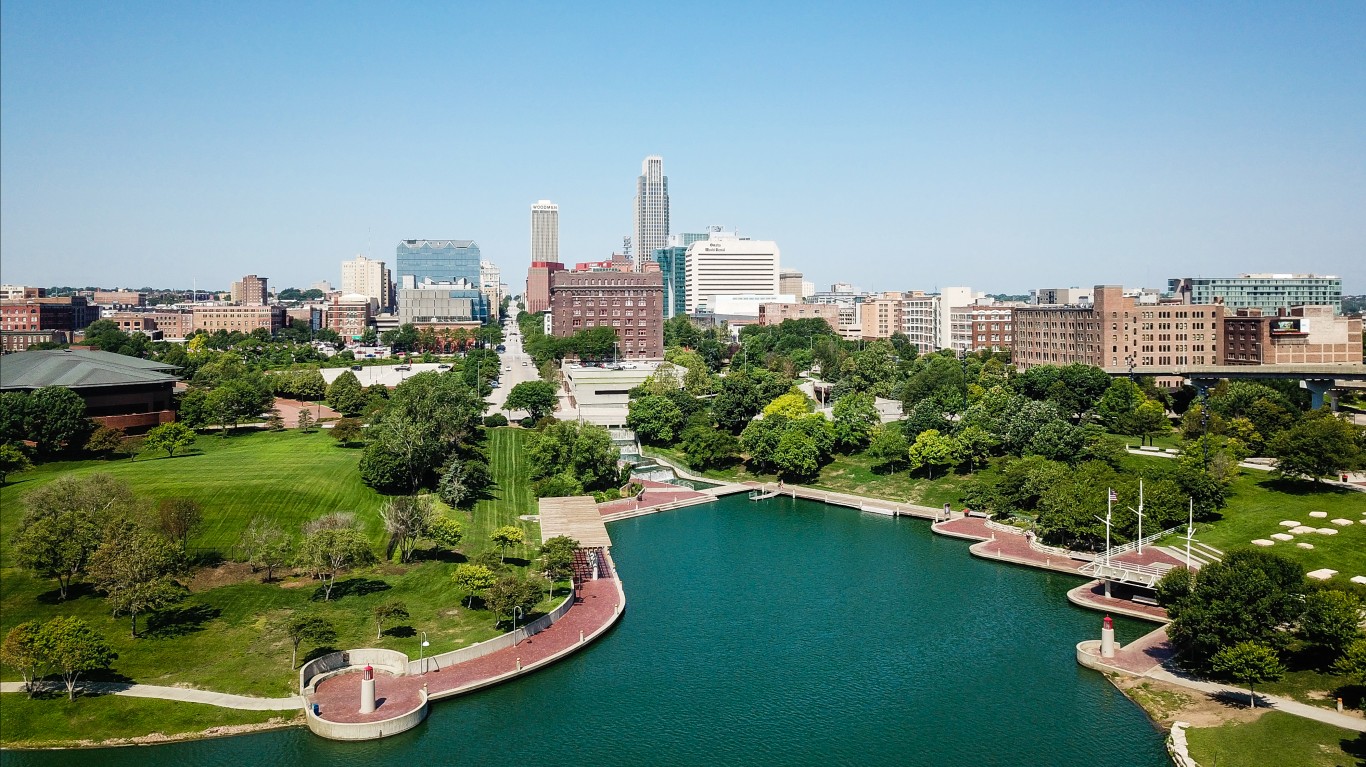
Nebraska: Omaha-Council Bluffs
> Concentrated poverty rate: 3.8% of poor pop. live in poor neighborhoods
> Overall poverty rate: 10.3% (state: 11.1%)
> Neighborhoods with concentrated poverty: 4 out of 254
> 5-yr. avg. unemployment rate: 11.9% in poor neighborhoods; 3.5% in all other neighborhoods
The Omaha-Council Bluffs metro area has a 3.8% concentrated poverty rate. While not especially high relative to metro areas in other parts of the country, it is the highest concentrated poverty rate of the three metro areas in Nebraska.
Though concentrated poverty is relatively rare in Omaha, disparity in economic opportunities is no less pronounced than it is in cities in other parts of the country. For example, unemployment stands at 11.9% in Omaha’s poorest neighborhoods, compared to 3.5% in the rest of the metro area. Additionally, the households in the metro area’s high-poverty neighborhoods earn an average of just $31,963 a year, nearly one-third the average income of $89,050 in the city’s other neighborhoods.

Nevada: Las Vegas-Henderson-Paradise
> Concentrated poverty rate: 5.1% of poor pop. live in poor neighborhoods
> Overall poverty rate: 13.7% (state: 13.1%)
> Neighborhoods with concentrated poverty: 11 out of 487
> 5-yr. avg. unemployment rate: 12.1% in poor neighborhoods; 6.3% in all other neighborhoods
Of the three metropolitan areas in Nevada, Las Vegas is the only one with neighborhoods where 40% or more of residents live below the poverty line. The 11 neighborhoods in the metro area with concentrated poverty are home to 5.1% of the 295,000 people in Las Vegas who live below the poverty line.
Homeownership is one of the most practical ways to build wealth in the United States. In Las Vegas’ poorest neighborhoods, the homeownership rate is only 9.1%. Meanwhile, across the rest of the city, the homeownership rate stands at 54.5%.
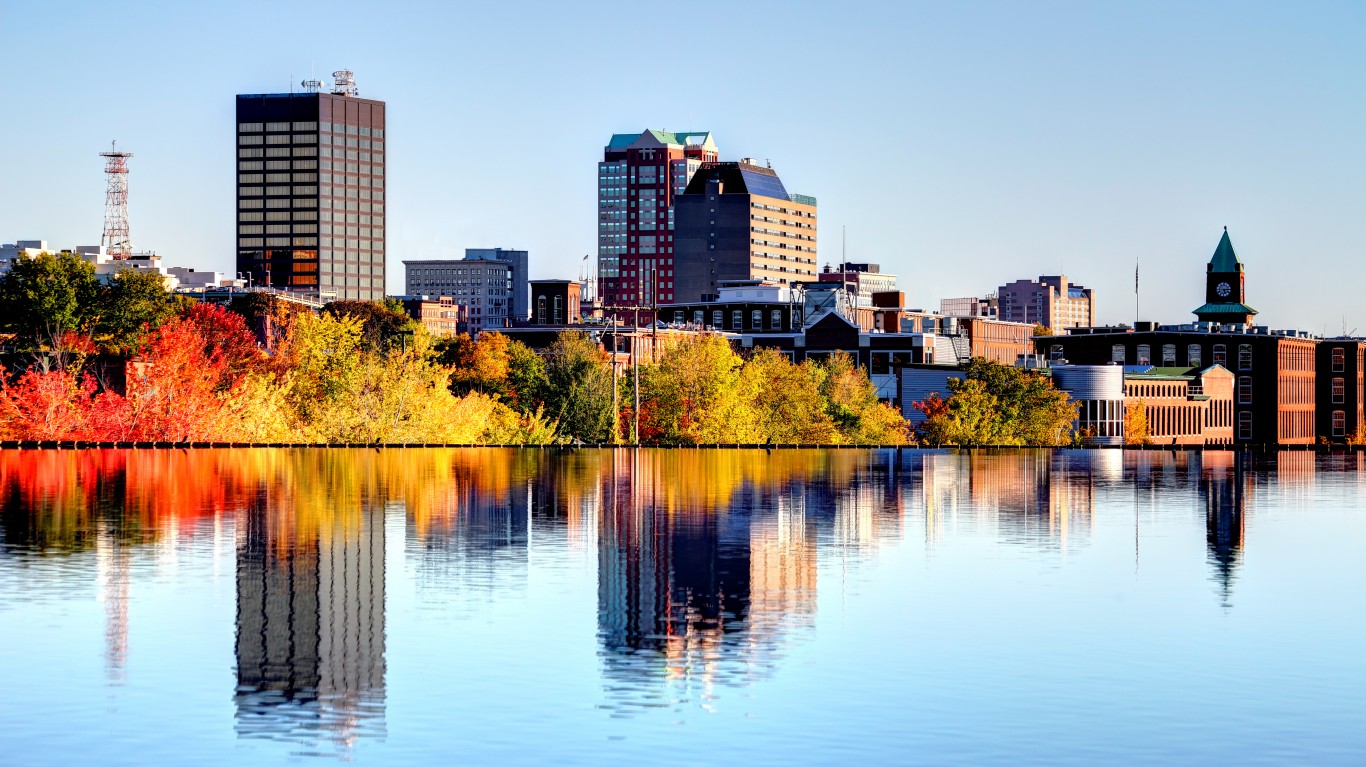
New Hampshire: Manchester-Nashua
> Concentrated poverty rate: 2.9% of poor pop. live in poor neighborhoods
> Overall poverty rate: 7.8% (state: 7.6%)
> Neighborhoods with concentrated poverty: 1 out of 85
> 5-yr. avg. unemployment rate: 8.8% in poor neighborhoods; 4.0% in all other neighborhoods
Manchester-Nashua is the only metropolitan area in New Hampshire, and ranks as having the worst concentrated poverty in the state by default only. Only one of the 85 census tracts in the metro area has a poverty rate of at least 40%, and it is home to 2.9% of the 31,500 metro area residents who live below the poverty line.
Economic opportunity is often limited in high-poverty areas, and in Manchester’s concentrated poverty neighborhood, the unemployment rate stands at 8.8%, more than double the 4.0% jobless rate in the rest of the city.
[in-text-ad-2]
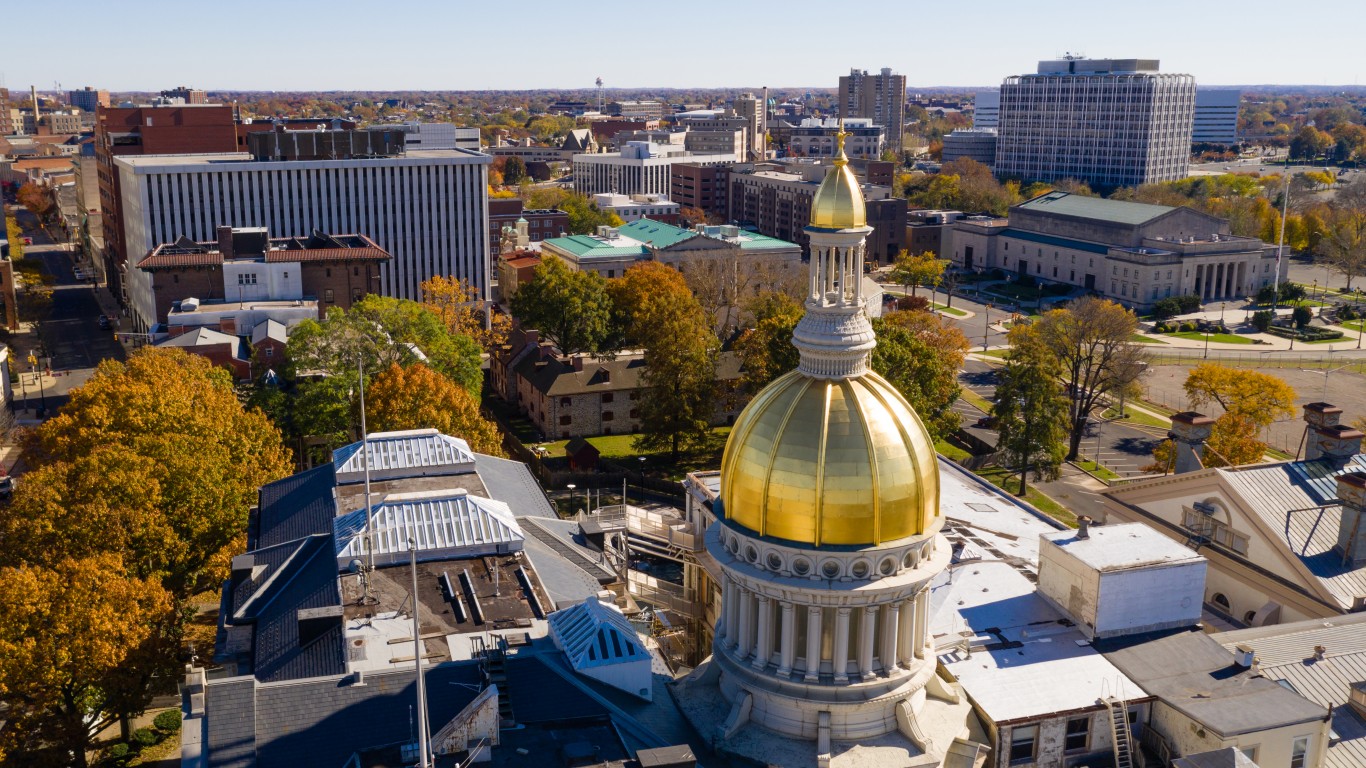
New Jersey: Trenton-Princeton
> Concentrated poverty rate: 21.3% of poor pop. live in poor neighborhoods
> Overall poverty rate: 11.7% (state: 10.0%)
> Neighborhoods with concentrated poverty: 7 out of 74
> 5-yr. avg. unemployment rate: 17.8% in poor neighborhoods; 5.6% in all other neighborhoods
More than one in every five residents of the Trenton-Princeton metro area living on poverty level income reside in a neighborhood of concentrated poverty — the largest share of any of New Jersey’s four metro areas.
Unemployment in Trenton’s seven high-poverty neighborhoods is over three times higher than it is in the other parts of the metro area. Disparities in income are even more pronounced. The average household in the city’s poor areas earns just $36,642 a year, compared to the average of $122,419 in the rest of the Trenton-Princeton area.
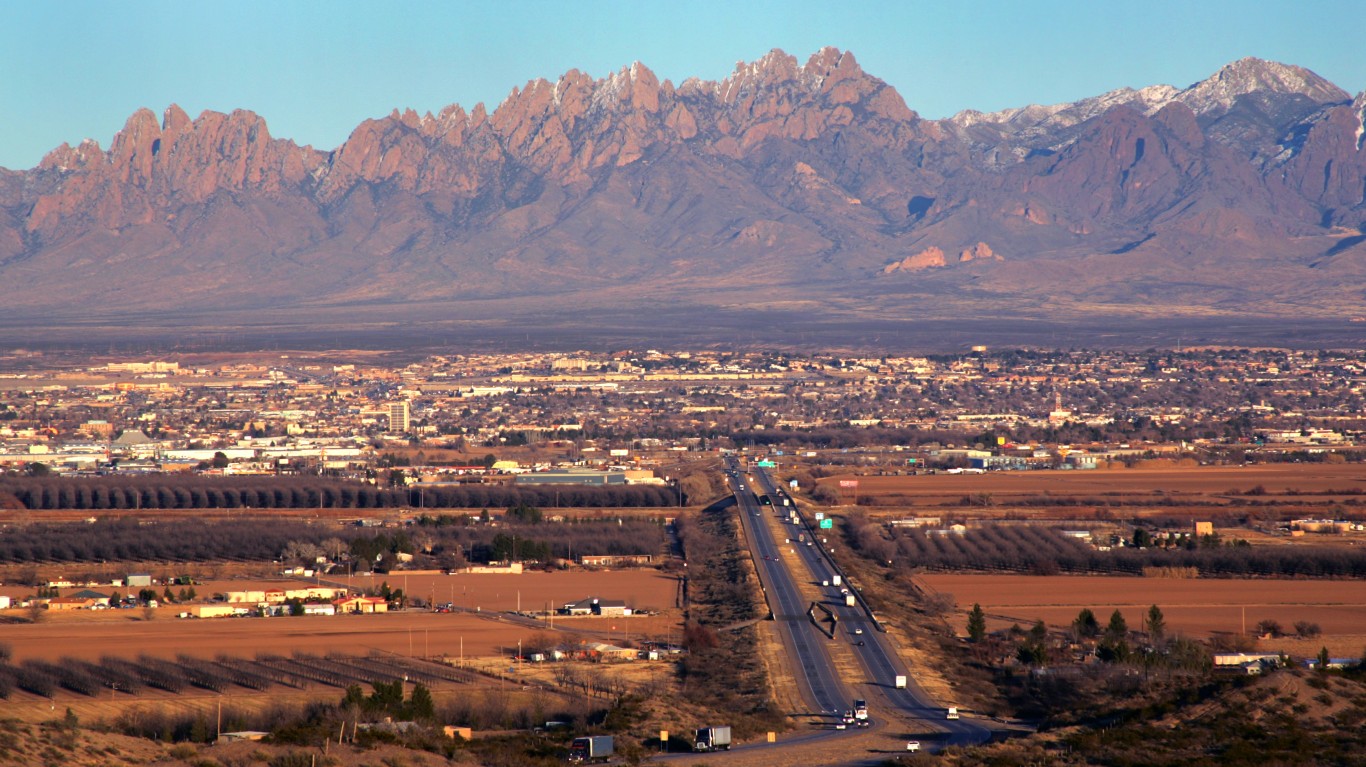
New Mexico: Las Cruces
> Concentrated poverty rate: 26.1% of poor pop. live in poor neighborhoods
> Overall poverty rate: 26.3% (state: 19.1%)
> Neighborhoods with concentrated poverty: 7 out of 40
> 5-yr. avg. unemployment rate: 10.3% in poor neighborhoods; 6.8% in all other neighborhoods
There are four metro areas in New Mexico — and of them, Las Cruces has far and away the highest concentrated poverty rate. An estimated 26.1% of the metro area’s poor population reside in neighborhoods with poverty rates of at least 40%. None of the other metro areas in the state have a concentrated poverty rate above 10%.
Las Cruces is one of the poorest metropolitan areas in the United States. The overall poverty rate in the city of 26.3% ranks behind only three other U.S. metros and is well above the 19.1% poverty rate across New Mexico, which itself is the third highest among states.
[in-text-ad]
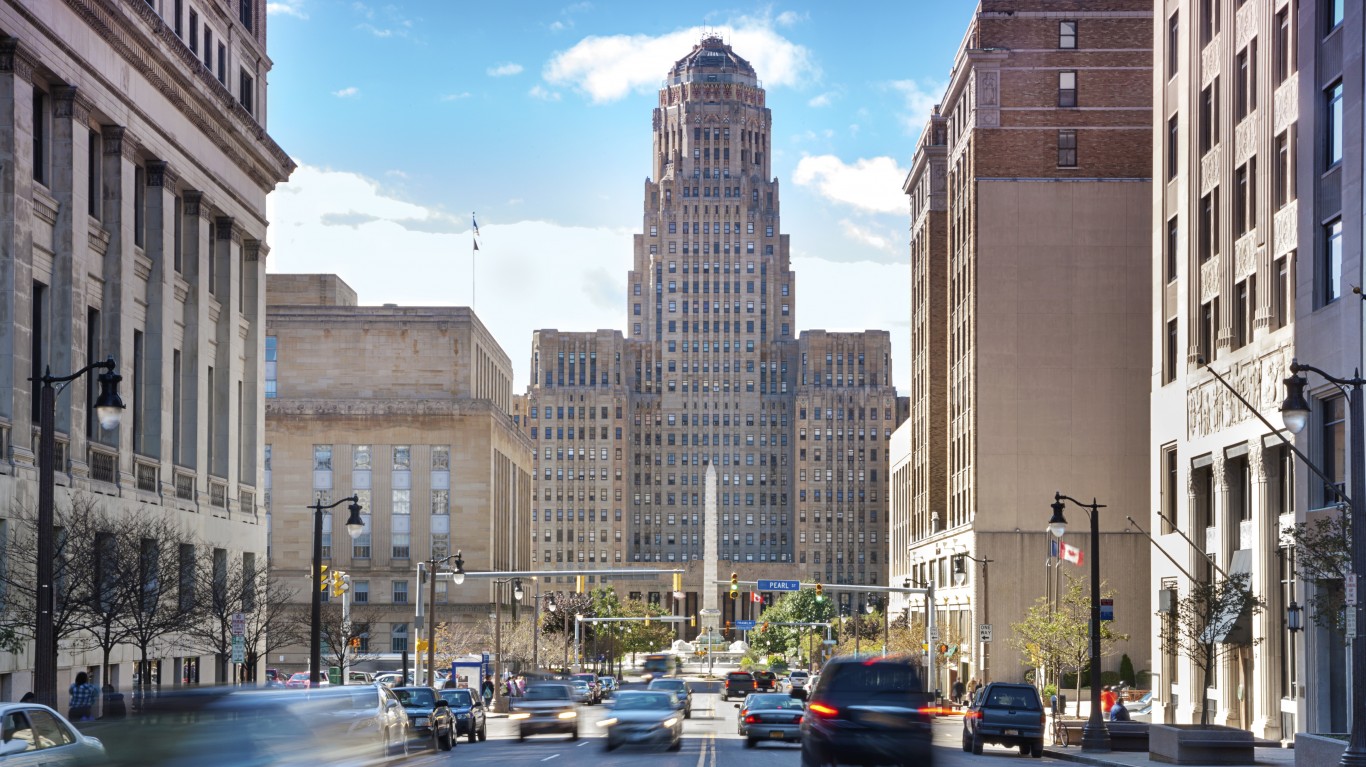
New York: Buffalo-Cheektowaga
> Concentrated poverty rate: 27.4% of poor pop. live in poor neighborhoods
> Overall poverty rate: 14.0% (state: 14.1%)
> Neighborhoods with concentrated poverty: 31 out of 291
> 5-yr. avg. unemployment rate: 9.1% in poor neighborhoods; 4.1% in all other neighborhoods
There are 13 metropolitan areas in New York state, and of them, Buffalo is the only one where more than one in four residents living below the poverty line reside in a neighborhood where 40% of the population live in poverty.
Despite having the worst economic segregation in the state, with 27.4% of poor residents concentrated in high-poverty neighborhoods, Buffalo does not have an especially large poor population. Only 14.0% of metro area residents live below the poverty line, compared to 14.1% of all New Yorkers. Additionally, other metro areas in the state, like Binghamton, Ithaca, and Utica, all have poverty rates over 15%.
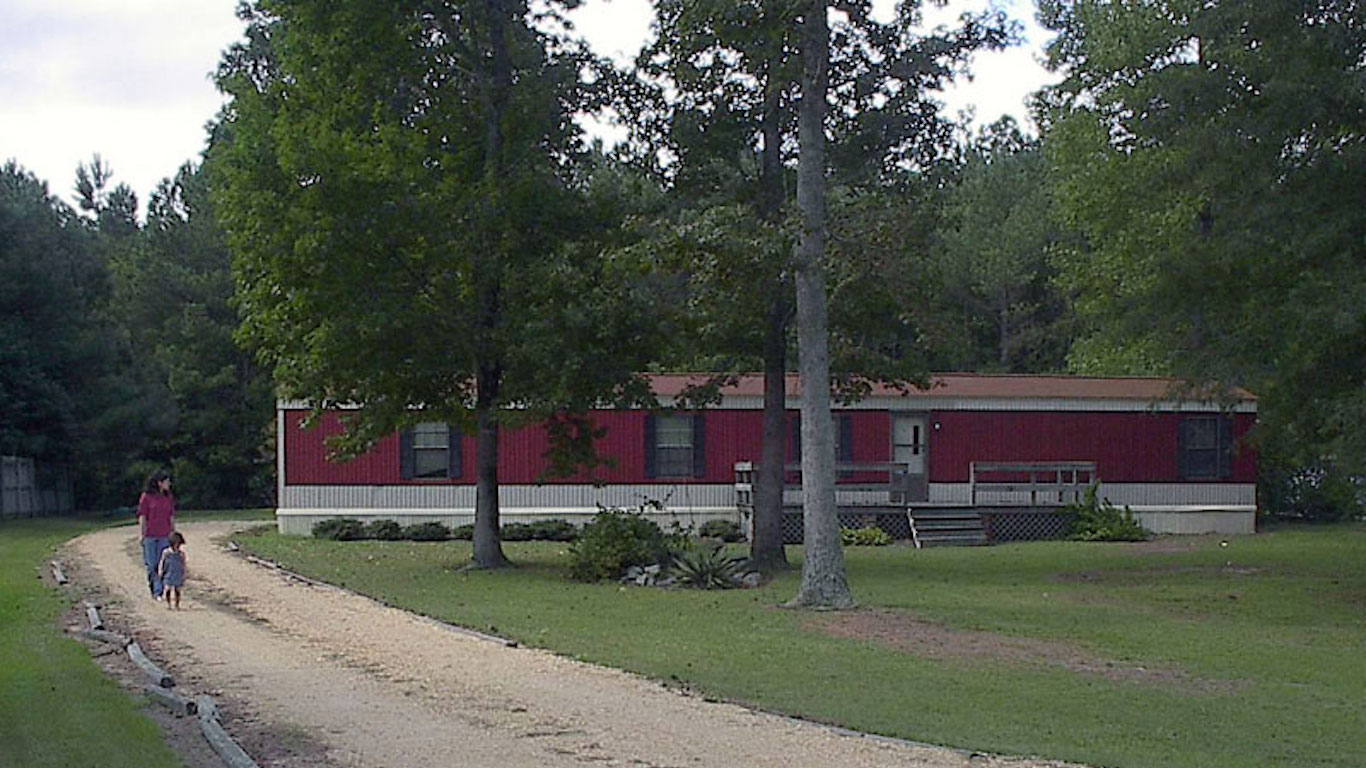
North Carolina: Goldsboro
> Concentrated poverty rate: 12.5% of poor pop. live in poor neighborhoods
> Overall poverty rate: 20.2% (state: 14.7%)
> Neighborhoods with concentrated poverty: 2 out of 26
> 5-yr. avg. unemployment rate: 15.9% in poor neighborhoods; 5.8% in all other neighborhoods
In Goldsboro, North Carolina, 12.5% of those living below the poverty line reside in a high-poverty neighborhood, the largest share of any metro area in the state where the presence of college and university students does not have an outsized influence on concentrated poverty.
Economic opportunity is often limited in high-poverty areas, and in Goldsboro’s concentrated poverty neighborhoods, the unemployment rate stands at 15.9%, more than double the 5.8% jobless rate in the rest of the city.
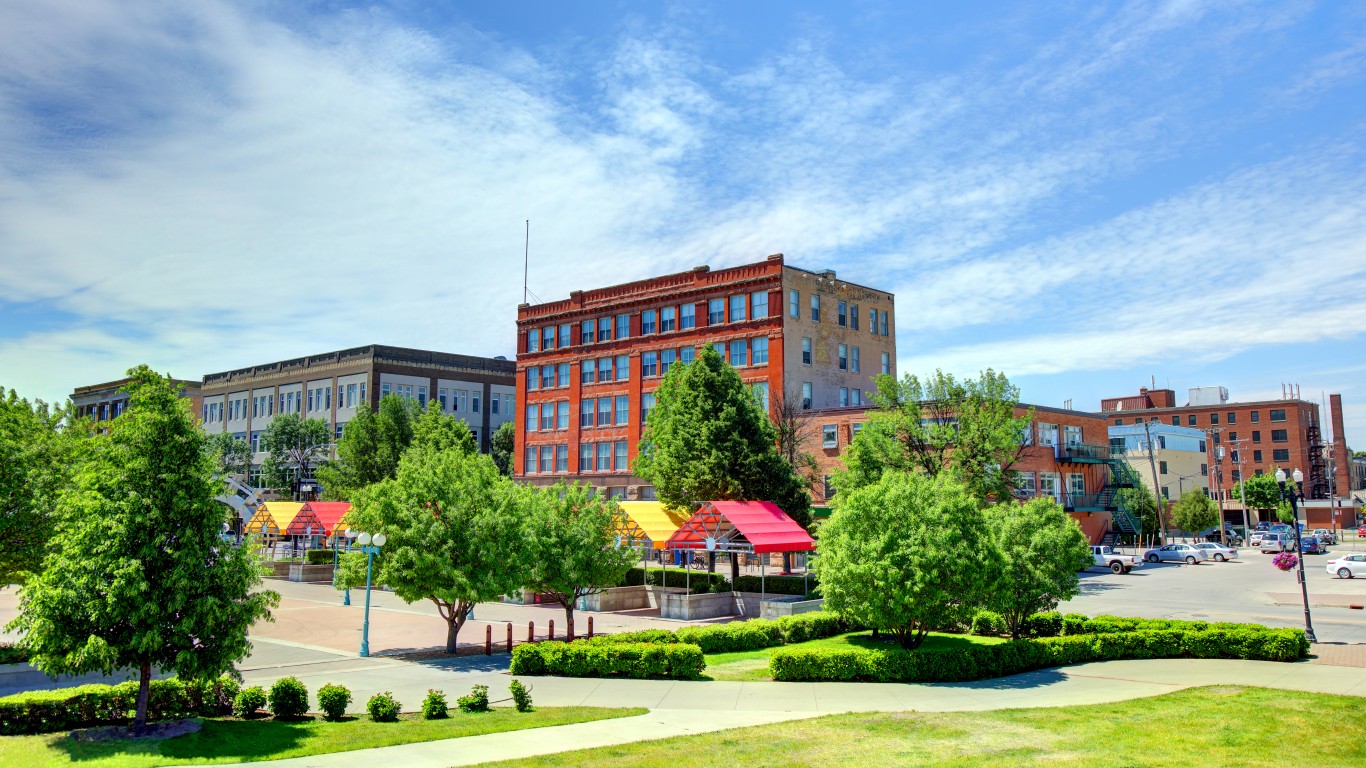
North Dakota: No metro area with concentrated poverty
> State poverty rate: 10.7%
None of North Dakota’s three metro areas — Bismarck, Fargo, and Grand Forks — have any neighborhood in which 40% or more of the population live below the poverty line. Grand Forks, where 13.9% of the population live below the poverty line, is the only metro area in the state with a poverty rate that exceeds the 10.7% rate across all of North Dakota.
In the United States, the likelihood of living below the poverty line or living in concentrated poverty goes down as educational attainment goes up. In each metro area in North Dakota, the share of adults with a bachelor’s degree is higher than the 30.0% share across the state as a whole.
[in-text-ad-2]
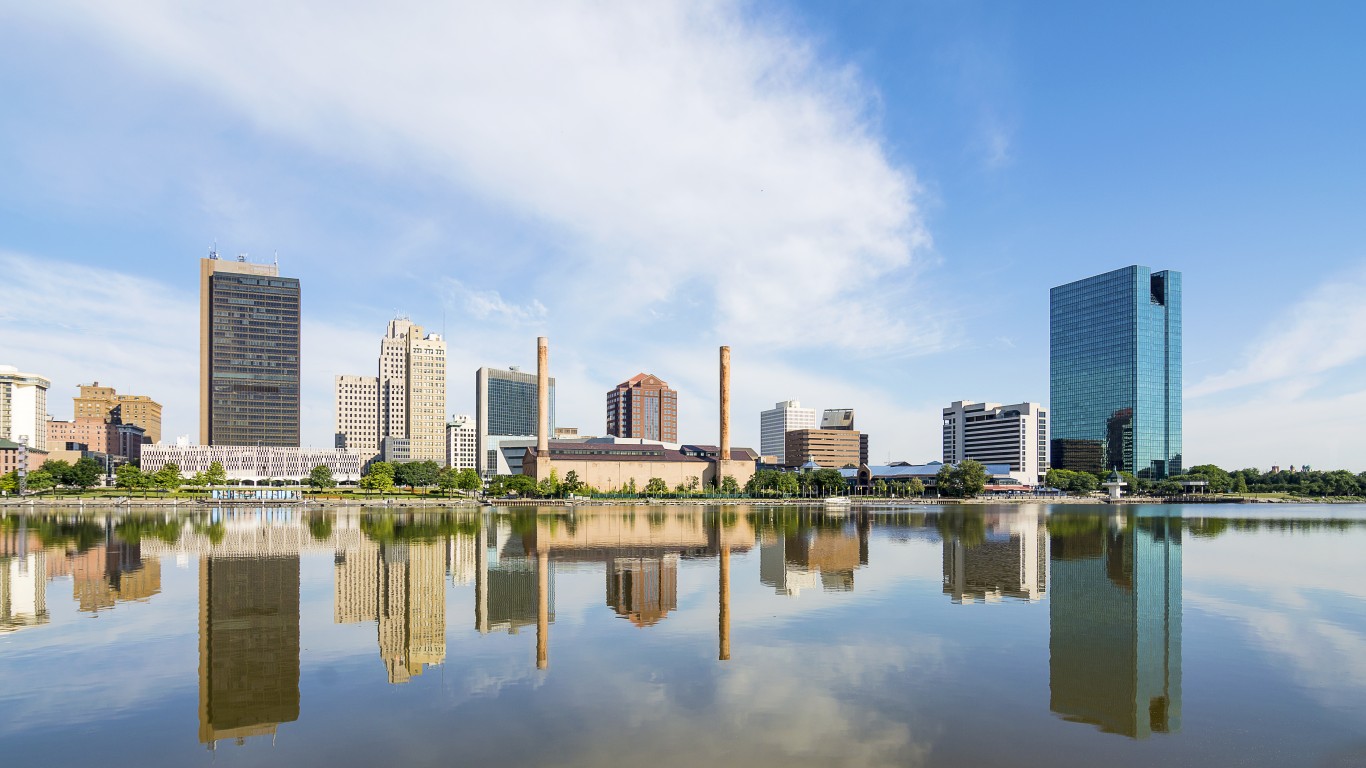
Ohio: Toledo
> Concentrated poverty rate: 26.0% of poor pop. live in poor neighborhoods
> Overall poverty rate: 16.0% (state: 14.0%)
> Neighborhoods with concentrated poverty: 25 out of 173
> 5-yr. avg. unemployment rate: 14.4% in poor neighborhoods; 5.3% in all other neighborhoods
Toledo is the only one of the 11 metro areas in Ohio where more than one in every four residents living below the poverty line are in a high-poverty neighborhood — where 40% or more of the population also live below the poverty line.
Financial hardship in Toledo’s high-poverty neighborhoods is further evidenced by low incomes. The average household in the 25 high-poverty neighborhoods in the metro area earns just $32,298 a year — compared to $76,318 in the rest of the metro area.
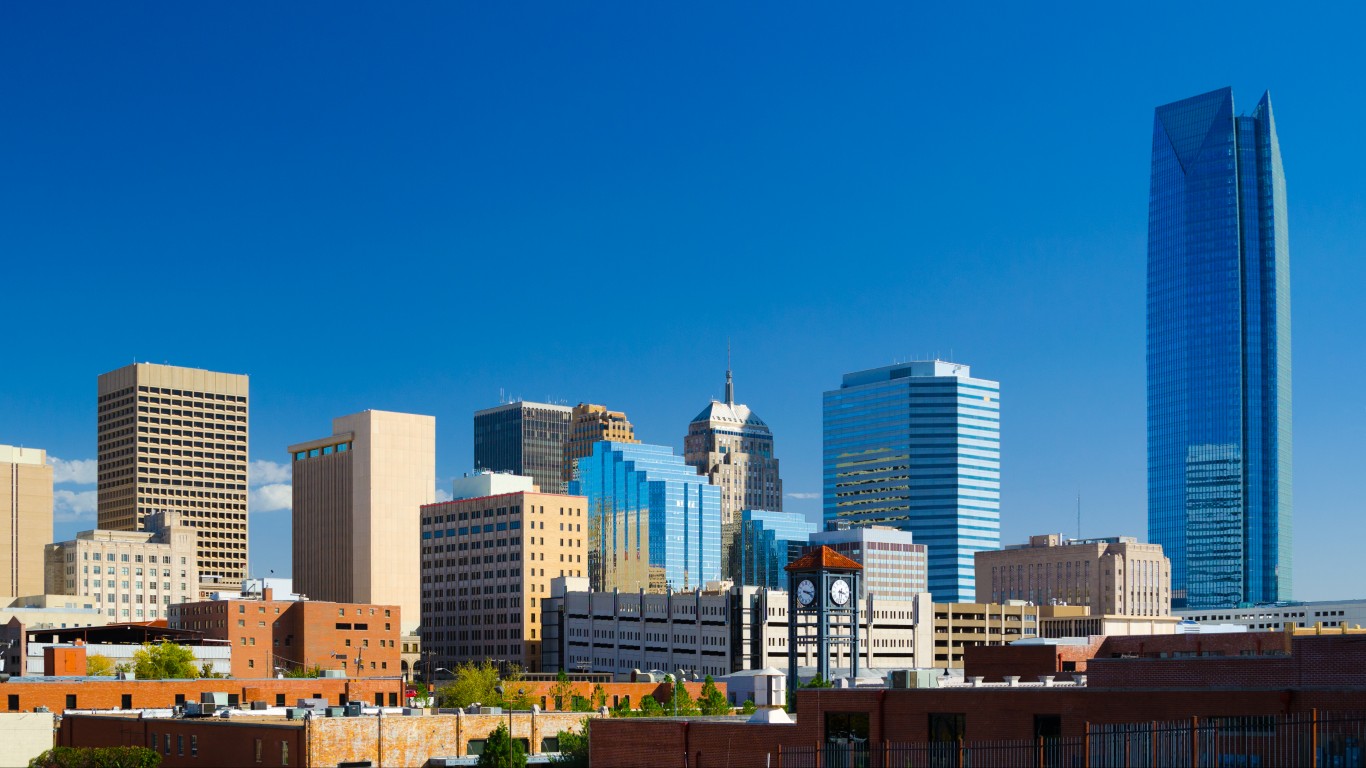
Oklahoma: Oklahoma City
> Concentrated poverty rate: 9.2% of poor pop. live in poor neighborhoods
> Overall poverty rate: 13.7% (state: 15.7%)
> Neighborhoods with concentrated poverty: 13 out of 347
> 5-yr. avg. unemployment rate: 10.1% in poor neighborhoods; 4.1% in all other neighborhoods
Oklahoma City has the highest concentrated poverty rate of any of Oklahoma’s four metro areas. There are about 184,500 people living below the poverty line in Oklahoma City, and 9.2% of them reside in communities of concentrated poverty.
High-poverty neighborhoods are often characterized by privation of amenities many Americans likely take for granted. For example, 1.2% of households in Oklahoma City’s poorest neighborhoods lack plumbing, and fewer than 70% of area households have internet access.
[in-text-ad]

Oregon: Medford
> Concentrated poverty rate: 2.3% of poor pop. live in poor neighborhoods
> Overall poverty rate: 15.5% (state: 13.2%)
> Neighborhoods with concentrated poverty: 1 out of 41
> 5-yr. avg. unemployment rate: 14.4% in poor neighborhoods; 5.8% in all other neighborhoods
The Medford metro area has a 2.3% concentrated poverty rate. While not especially high relative to metro areas in other parts of the country, it is the highest concentrated poverty rate of the metro areas in Oregon where the presence of college and university students does not have an outsized influence on concentrated poverty.
Though concentrated poverty is relatively rare in Medford, disparity in economic opportunities is no less pronounced than it is in cities in other parts of the country. For example, unemployment stands at 14.4% in Meadford’s poorest neighborhood, compared to 5.8% in the rest of the metro area. Additionally, the households in the metro area’s high-poverty neighborhood earn an average of just $29,857 a year, less than half the average income of $73,262 in the city’s other neighborhoods.
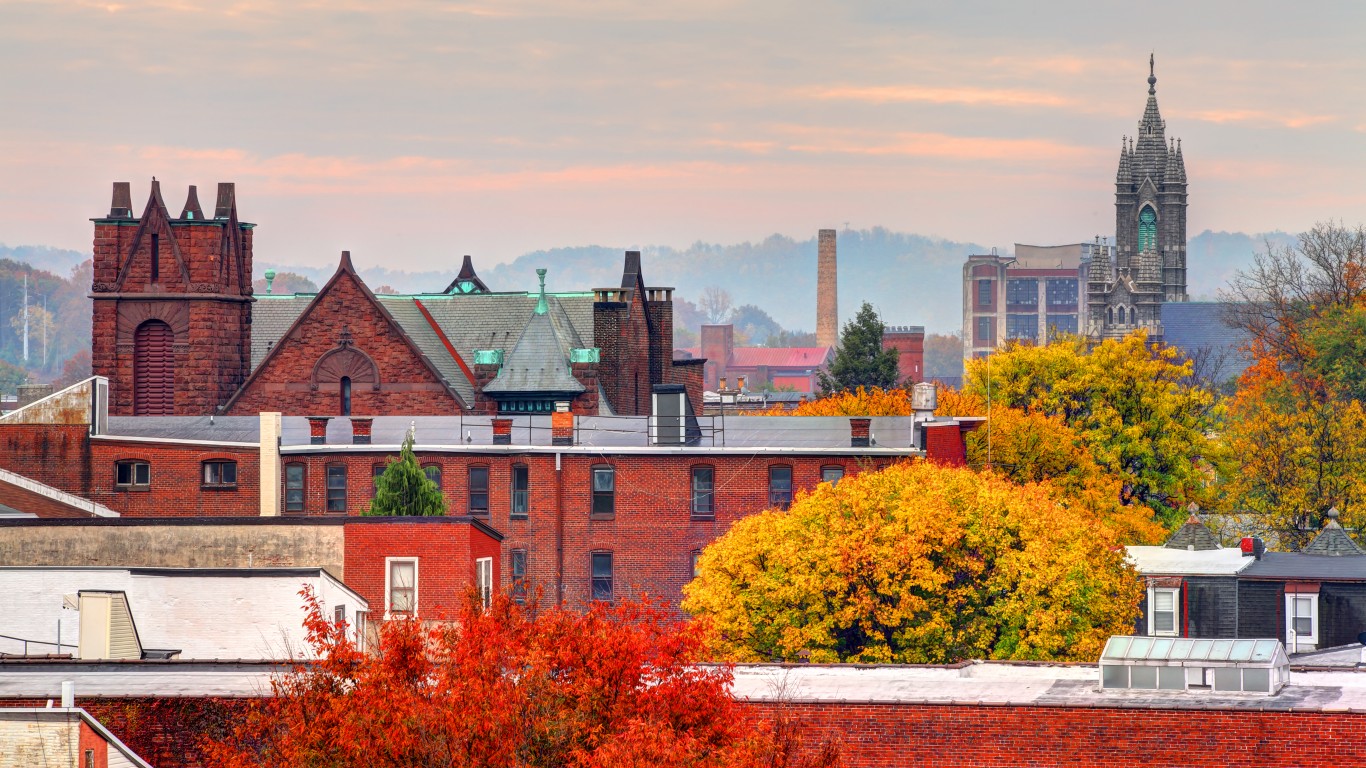
Pennsylvania: Reading
> Concentrated poverty rate: 28.8% of poor pop. live in poor neighborhoods
> Overall poverty rate: 12.0% (state: 12.4%)
> Neighborhoods with concentrated poverty: 9 out of 89
> 5-yr. avg. unemployment rate: 19.4% in poor neighborhoods; 5.1% in all other neighborhoods
Of the 18 metropolitan areas spread across Pennsylvania, Reading has the highest concentrated poverty rate. There are 48,000 people in Reading living below the poverty line, and 28.8% of them reside in high-poverty neighborhoods.
Despite having the worst economic segregation in the state, Reading does not have an especially large poor population. Only 12.0% of metro area residents live below the poverty line, compared to 12.4% of all Pennsylvanians. Additionally, other metro areas in the state, like Altoona, Erie, Johnstown, and Scranton, all have poverty rates over 14%.
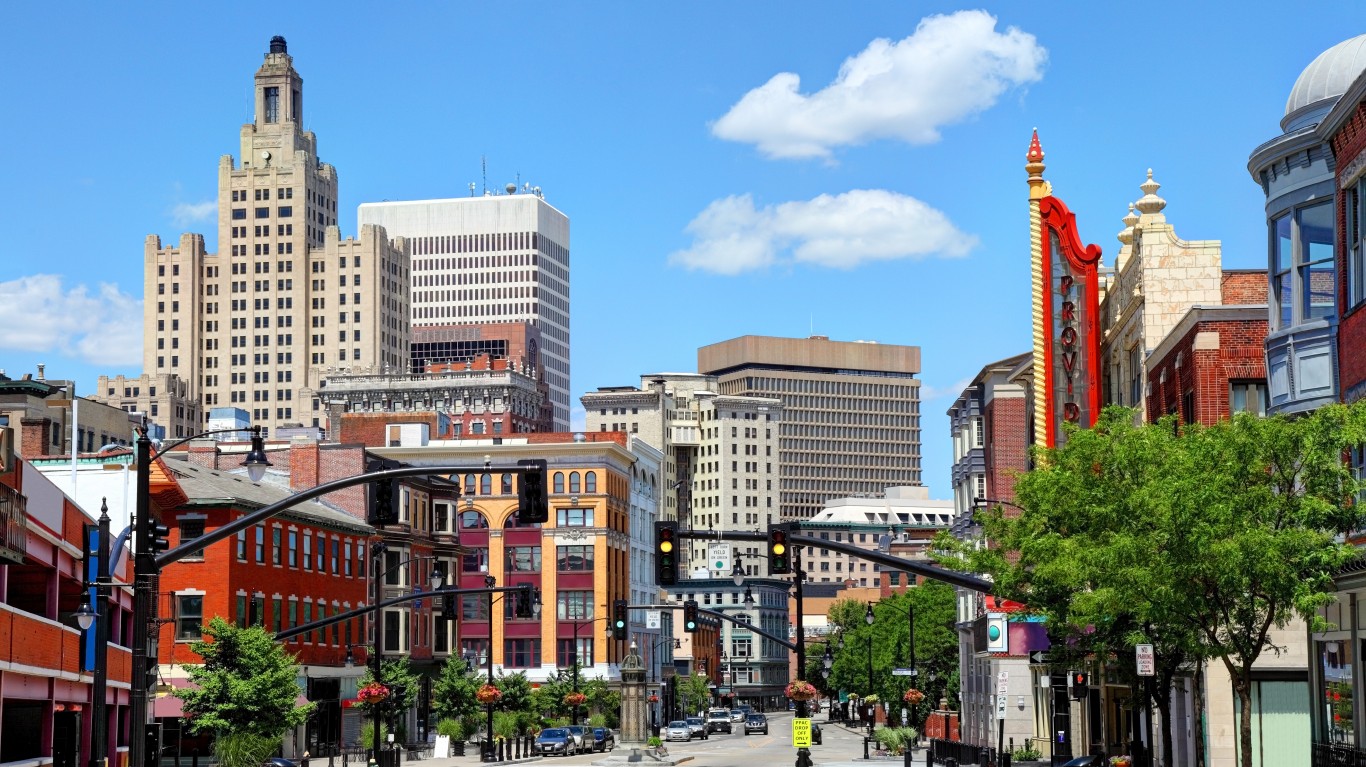
Rhode Island: Providence-Warwick
> Concentrated poverty rate: 4.0% of poor pop. live in poor neighborhoods
> Overall poverty rate: 12.0% (state: 12.4%)
> Neighborhoods with concentrated poverty: 4 out of 359
> 5-yr. avg. unemployment rate: 15.8% in poor neighborhoods; 5.2% in all other neighborhoods
Providence is the only metropolitan area in Rhode Island and ranks as having the worst concentrated poverty in the state by default only. Only four of the 359 census tracts in the metro area have a poverty rate of at least 40%, and they are home to 4.0% of the 185,700 metro area residents who live below the poverty line.
Economic opportunity is often limited in high-poverty areas, and in Providence’s concentrated poverty neighborhoods, the unemployment rate stands at 15.8%, more than three times the 5.2% jobless rate in the rest of the city.
[in-text-ad-2]
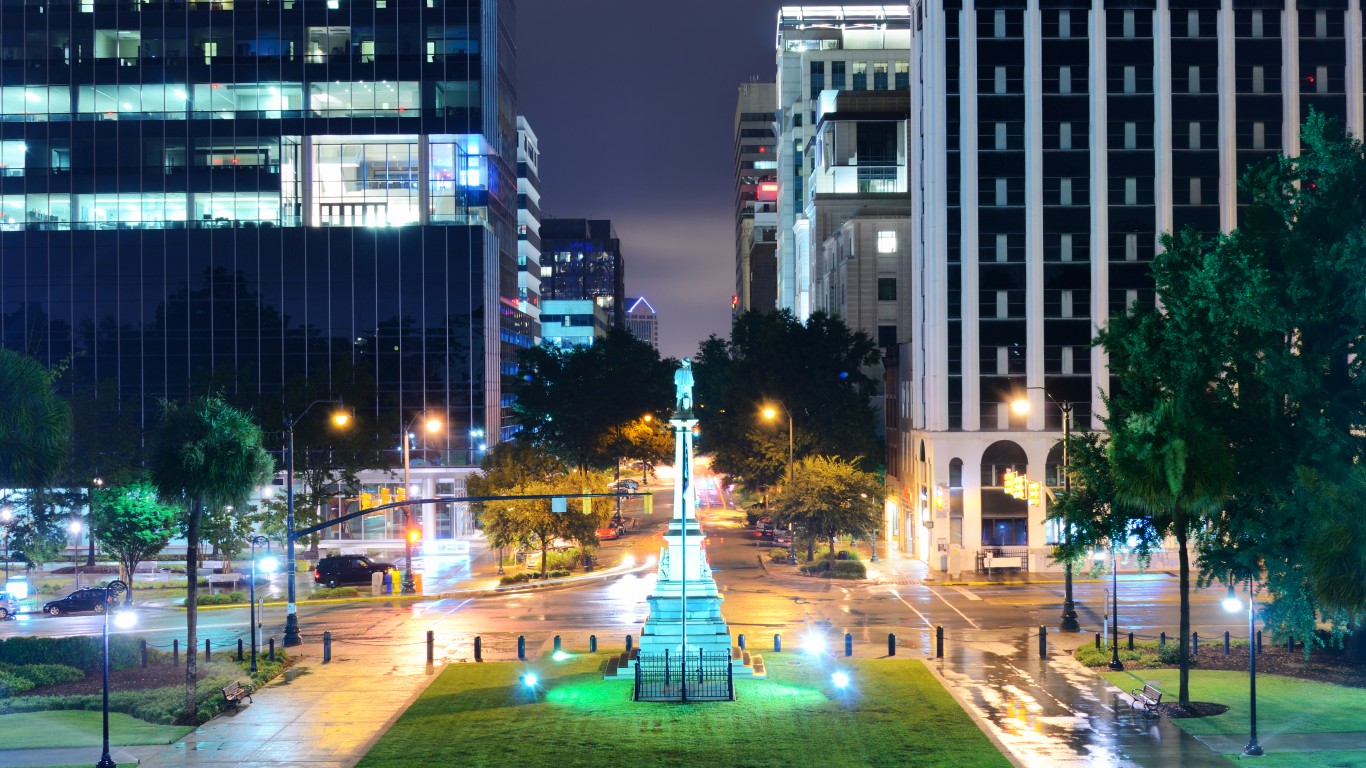
South Carolina: Columbia
> Concentrated poverty rate: 7.9% of poor pop. live in poor neighborhoods
> Overall poverty rate: 14.4% (state: 15.2%)
> Neighborhoods with concentrated poverty: 10 out of 185
> 5-yr. avg. unemployment rate: 14.9% in poor neighborhoods; 5.7% in all other neighborhoods
Of the eight metropolitan areas in South Carolina, Columbia, the state capital, has the highest concentrated poverty rate. There are 111,800 people in Columbia living below the poverty line, and 7.9% of them reside in high-poverty neighborhoods.
Despite having the worst economic segregation in the state, Columbia does not have an especially large poor population. About 14.4% of metro area residents live below the poverty line, compared to 15.2% of all South Carolinians. Additionally, two other metro areas in the state — Florence and Sumpter — have poverty rates over 18%.

South Dakota: No metro area with concentrated poverty
> State poverty rate: 13.1%
Rapid City and Sioux Falls are the only two metropolitan areas in South Dakota — and neither of them has any neighborhoods where 40% or more of the population live below the poverty line. In fact, both metro areas have poverty rates below the 13.1% statewide rate, at 12.4% in Rapid City and 8.7% in Sioux Falls.
[in-text-ad]

Tennessee: Memphis
> Concentrated poverty rate: 24.6% of poor pop. live in poor neighborhoods
> Overall poverty rate: 17.5% (state: 15.2%)
> Neighborhoods with concentrated poverty: 41 out of 307
> 5-yr. avg. unemployment rate: 15.8% in poor neighborhoods; 6.1% in all other neighborhoods
Memphis has far and away the highest concentrated poverty rate of any of the 10 metropolitan areas in Tennessee. Nearly 25% of the poor population in the Memphis metro area reside in high-poverty neighborhoods. Meanwhile, the Jackson metro area has the second highest concentrated poverty rate in the state at 13.3% — over 10 percentage points below the rate in Memphis.
Memphis residents are also more likely to live below the poverty line than state residents overall. Memphis’ 17.5% poverty rate is the highest among Tennessee metro areas and well above the 15.2% statewide rate. The area’s high poverty is attributable in part to a lack of economic opportunity, as the local five-year average jobless rate of 6.8% is also the highest of any metro area in the state.
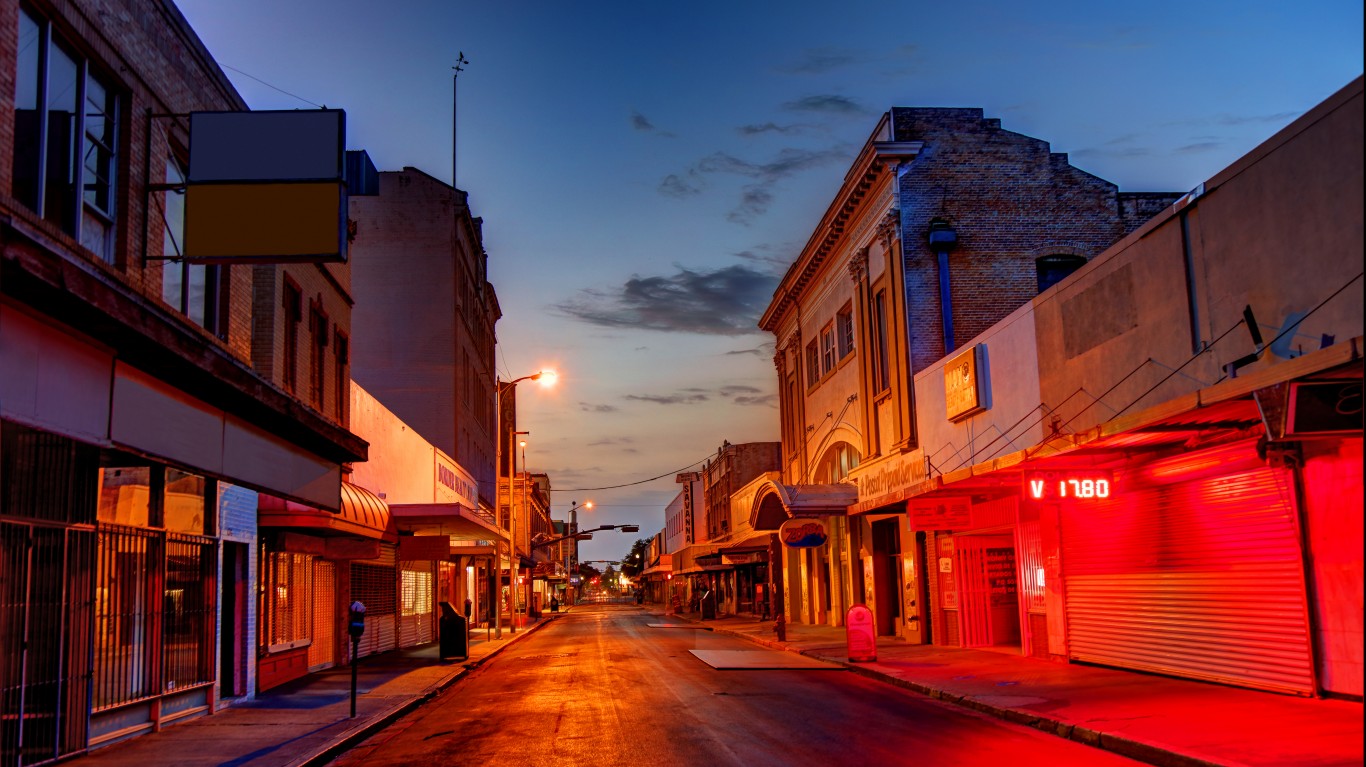
Texas: Laredo
> Concentrated poverty rate: 46.4% of poor pop. live in poor neighborhoods
> Overall poverty rate: 27.5% (state: 14.7%)
> Neighborhoods with concentrated poverty: 21 out of 60
> 5-yr. avg. unemployment rate: 6.3% in poor neighborhoods; 4.5% in all other neighborhoods
Laredo has the highest concentrated poverty rate in Texas, and one of the highest in the United States. An estimated 46.4% of Laredo’s poor population reside in high-poverty neighborhoods, well above the 27.2% concentrated poverty rate in Waco, the second highest rate among Texas metro areas. Nationwide, Laredo’s concentrated poverty rate is second only to the 49.5% rate in Monroe, Louisiana.
Greater educational attainment typically leads to greater economic opportunity, and in Laredo, only about half of the 25 and older population have completed high school.

Utah: No metro area with concentrated poverty
> State poverty rate: 9.8%
There are five metropolitan areas in Utah, and two of them — Logan and Provo — have some neighborhoods of concentrated poverty. However, because these neighborhoods are also home to significant populations of college and university students, which can distort poverty figures, they were not considered. In Utah’s three remaining metro areas — Ogden, St. George, and Salt Lake City — there are no neighborhoods with poverty rates of 40% or higher.
Overall, the Logan metro area has the highest poverty rate in Utah, at 13.5%. Meanwhile, Utah has a 9.8% poverty rate, and most metro areas in the state also have poverty rates below 10%.
[in-text-ad-2]
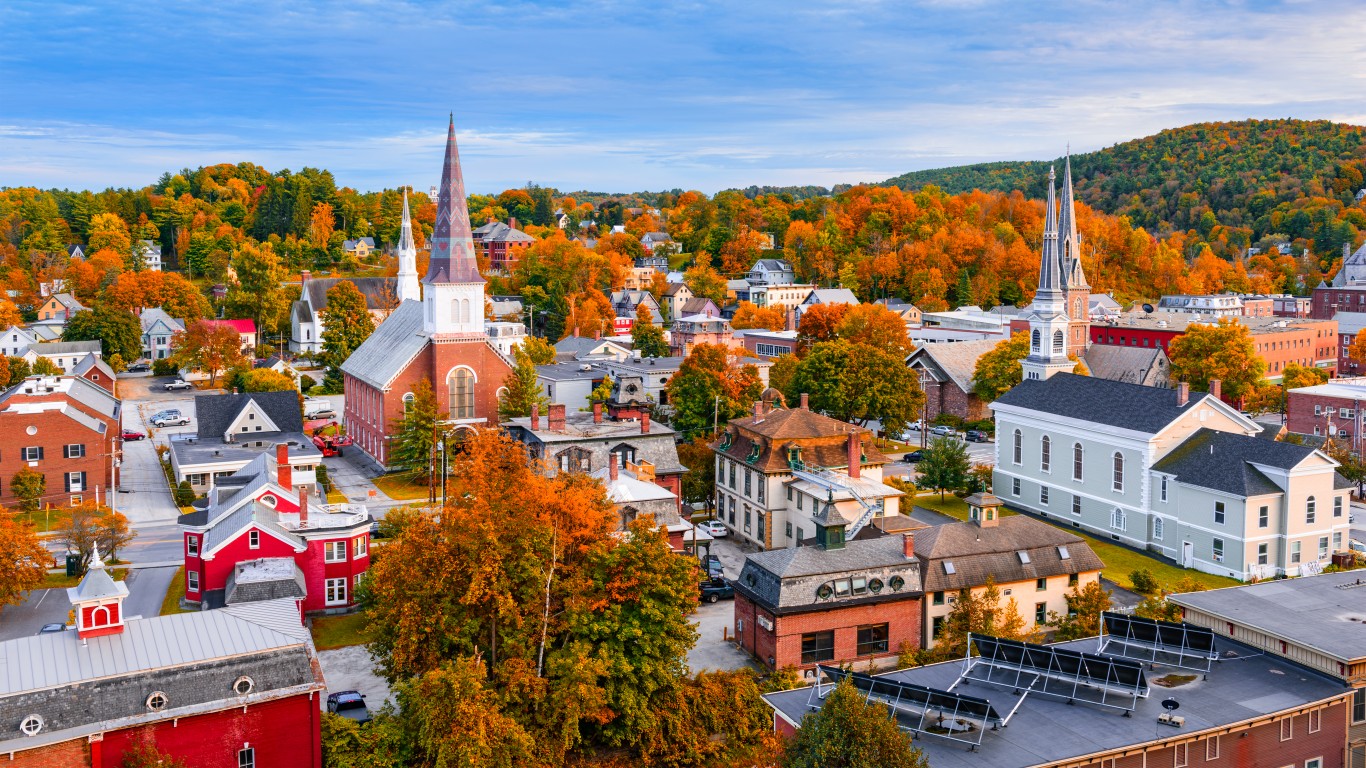
Vermont: No metro area with concentrated poverty
> State poverty rate: 10.9%
Burlington is the only metro area in Vermont, and there are no neighborhoods in the city with poverty rates of 40% or higher. The overall poverty rate in Burlington of 9.9% is a full percentage point below the statewide average.
Employment opportunities appear to be about as common in Burlington as they are across the state as a whole. Over the last five years, the average unemployment rate in the area was 3.4%, only slightly lower than the 3.6% jobless rate across the state over that time.

Virginia: Roanoke
> Concentrated poverty rate: 15.9% of poor pop. live in poor neighborhoods
> Overall poverty rate: 12.9% (state: 10.6%)
> Neighborhoods with concentrated poverty: 2 out of 65
> 5-yr. avg. unemployment rate: 9.0% in poor neighborhoods; 4.4% in all other neighborhoods
There are nine metro areas in Virginia — and five of them have no neighborhoods with poverty rates of 40% or higher. Of the four remaining metro areas in the state, Roanoke has by far the highest concentrated poverty rate. An estimated 15.9% of Roanoke’s poor population reside in high-poverty neighborhoods, well above the 10.8% concentrated poverty rate in Richmond, the second highest rate among Virginia metro areas.
Areas with high concentrations of poverty typically have fewer opportunities for local residents to improve their financial situation. In Roanoke’s poorest communities, 9.0% of the labor force are unemployed, more than double the 4.4% jobless rate in the rest of the metro area.
[in-text-ad]
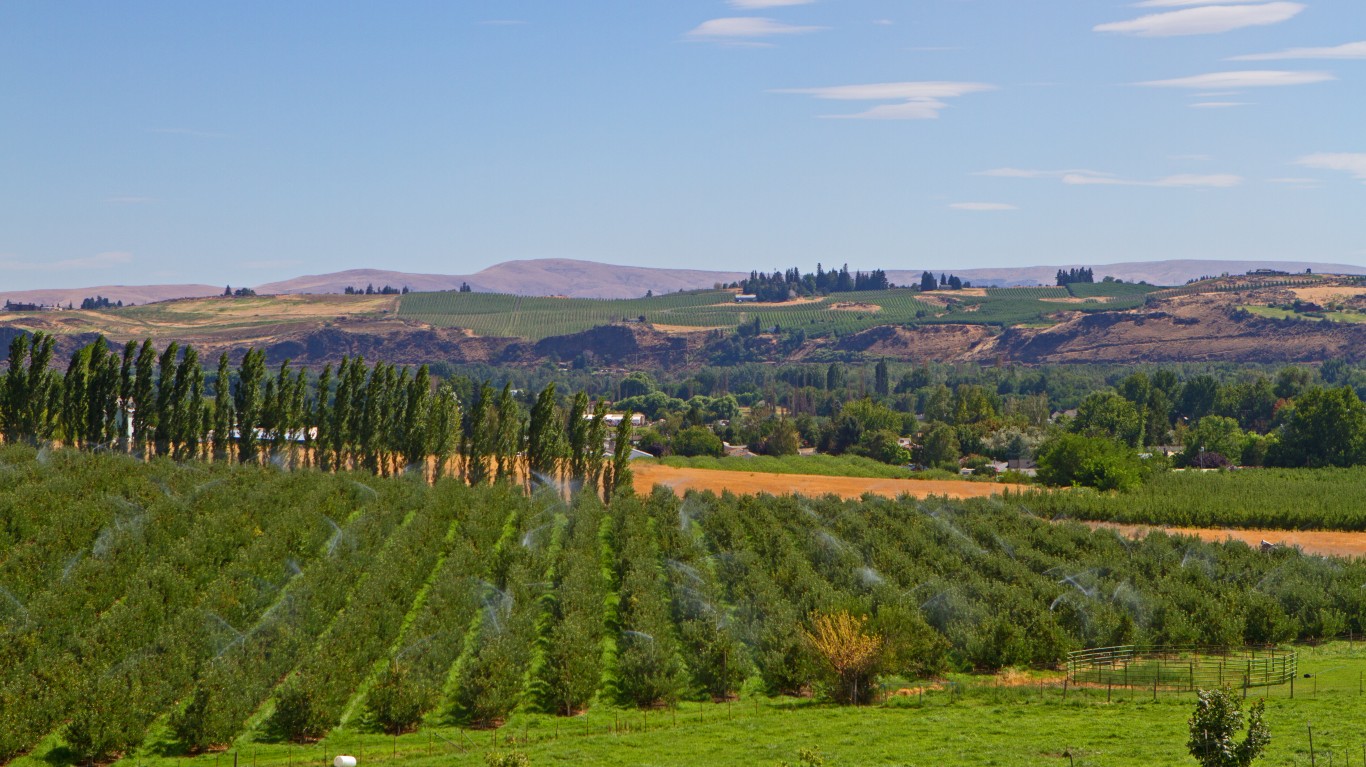
Washington: Yakima
> Concentrated poverty rate: 8.5% of poor pop. live in poor neighborhoods
> Overall poverty rate: 17.4% (state: 10.8%)
> Neighborhoods with concentrated poverty: 2 out of 45
> 5-yr. avg. unemployment rate: 7.0% in poor neighborhoods; 6.4% in all other neighborhoods
There are 42,800 people living below the poverty line in the Yakima, Washington, metro area, and 8.5% of them reside in high-poverty neighborhoods. Though the Bellingham metro area has a larger concentration of poor residents living in high-poverty neighborhoods, those same areas are also home to large shares of college and university students, and as a result, Bellingham’s concentrated poverty rate is not likely an accurate representation of financial hardship in the area.
Not only does Yakima have a high concentrated poverty rate relative to the rest of the state, it is also the poorest metro area in the state. The local poverty rate of 17.4% is at least 3 percentage points higher than each of the 10 other metropolitan areas in Washington and is well above the 10.8% statewide poverty rate.
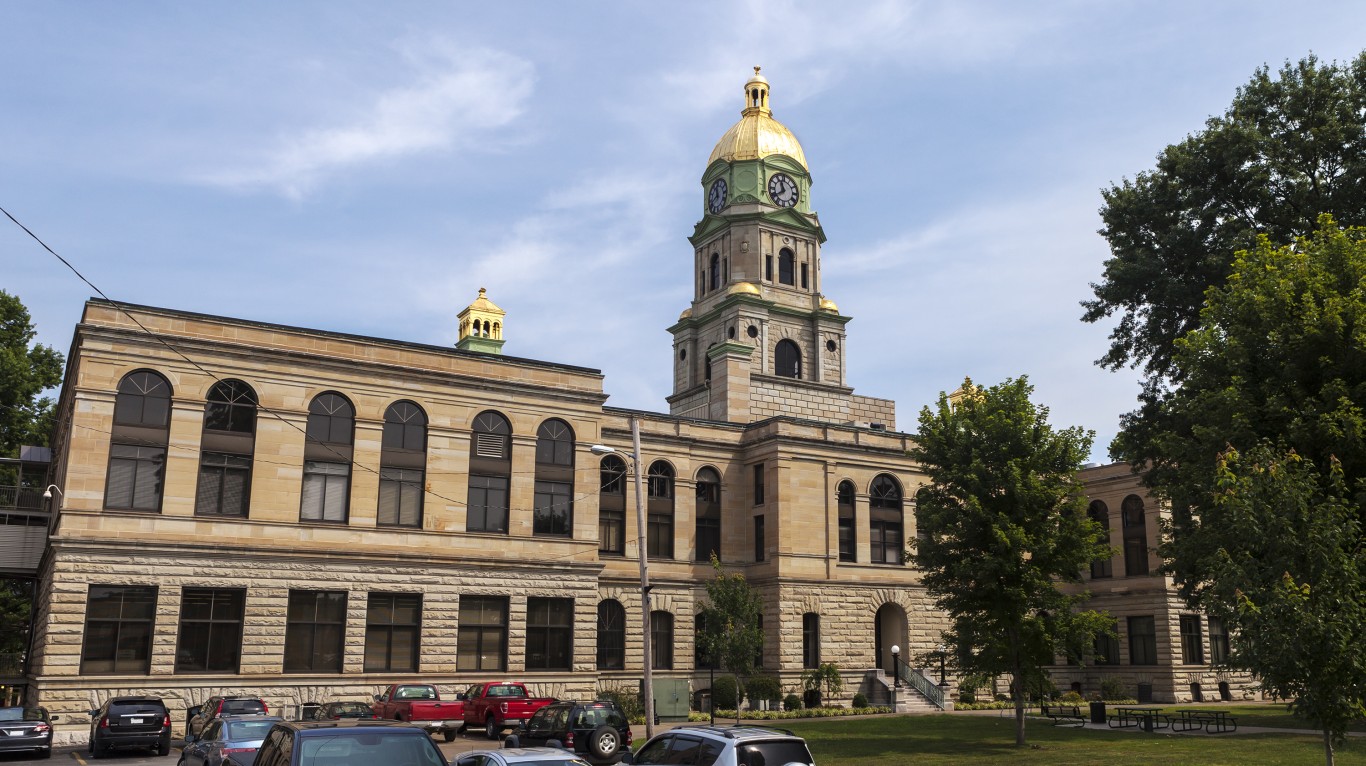
West Virginia: Huntington-Ashland
> Concentrated poverty rate: 14.8% of poor pop. live in poor neighborhoods
> Overall poverty rate: 18.8% (state: 17.6%)
> Neighborhoods with concentrated poverty: 9 out of 94
> 5-yr. avg. unemployment rate: 8.9% in poor neighborhoods; 5.4% in all other neighborhoods
West Virginia’s Huntington-Ashland metro area has by far the highest concentrated poverty rate in the state. An estimated 14.8% of the local population living below the poverty line reside in one of nine area neighborhoods in which 40% of the population or more also live in poverty. The Charleston metro area has the second highest concentrated poverty rate in the state, which, at 7.4%, is half the comparable rate in Huntington-Ashland.
Homeownership is one of the most practical ways to build wealth in the United States, but in Huntington’s poorest neighborhoods, few residents own their home. The average homeownership rate across concentrated poverty neighborhoods in the city is just 37.4%, compared to the 73.9% homeownership rate across the metro area’s other neighborhoods.
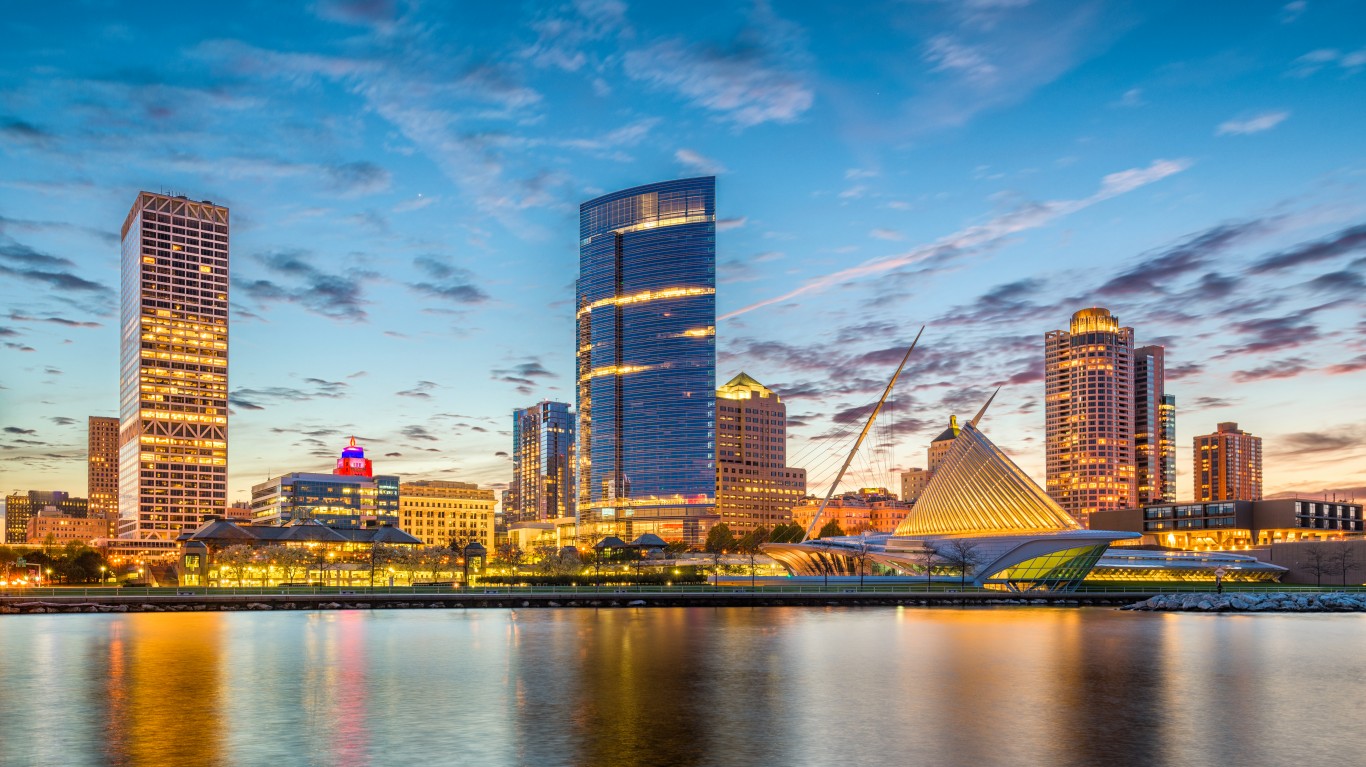
Wisconsin: Milwaukee-Waukesha
> Concentrated poverty rate: 17.4% of poor pop. live in poor neighborhoods
> Overall poverty rate: 13.1% (state: 11.3%)
> Neighborhoods with concentrated poverty: 37 out of 423
> 5-yr. avg. unemployment rate: 10.8% in poor neighborhoods; 4.1% in all other neighborhoods
There are a dozen metro areas in Wisconsin, and most of them have no neighborhoods with poverty rates of 40% or higher. Of those that do, Milwaukee has the worst economic segregation, with 17.4% of the poor population living in high-poverty neighborhoods. Overall, 37 of the 423 neighborhoods in Milwaukee have poverty rates of 40% or higher.
Areas with high concentrations of poverty typically have fewer opportunities for local residents to improve their financial situation. In Milwaukee’s poorest communities, 10.8% of the labor force are unemployed, more than double the 4.1% jobless rate in the rest of the metro area.
[in-text-ad-2]

Wyoming: No metro area with concentrated poverty
> State poverty rate: 11.0%
Casper and Cheyenne are the only two metropolitan areas in Wyoming — and neither of them have any neighborhoods where 40% or more of the population live below the poverty line. In fact, both metro areas have overall poverty rates below the 11.0% statewide rate, at 9.4% in Casper and 9.9% in Cheyenne.
Travel Cards Are Getting Too Good To Ignore (sponsored)
Credit card companies are pulling out all the stops, with the issuers are offering insane travel rewards and perks.
We’re talking huge sign-up bonuses, points on every purchase, and benefits like lounge access, travel credits, and free hotel nights. For travelers, these rewards can add up to thousands of dollars in flights, upgrades, and luxury experiences every year.
It’s like getting paid to travel — and it’s available to qualified borrowers who know where to look.
We’ve rounded up some of the best travel credit cards on the market. Click here to see the list. Don’t miss these offers — they won’t be this good forever.
Thank you for reading! Have some feedback for us?
Contact the 24/7 Wall St. editorial team.
 24/7 Wall St.
24/7 Wall St. 24/7 Wall St.
24/7 Wall St. 24/7 Wall St.
24/7 Wall St.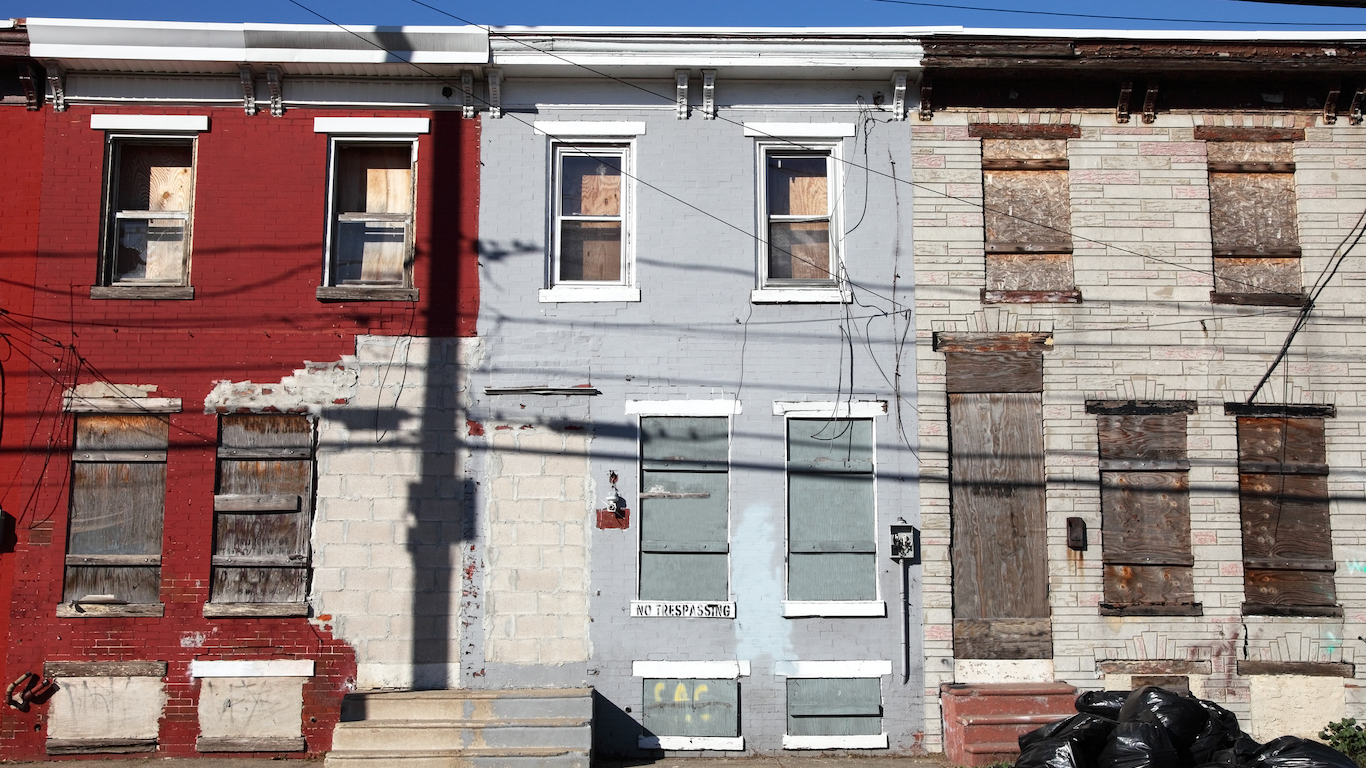 24/7 Wall St.
24/7 Wall St.